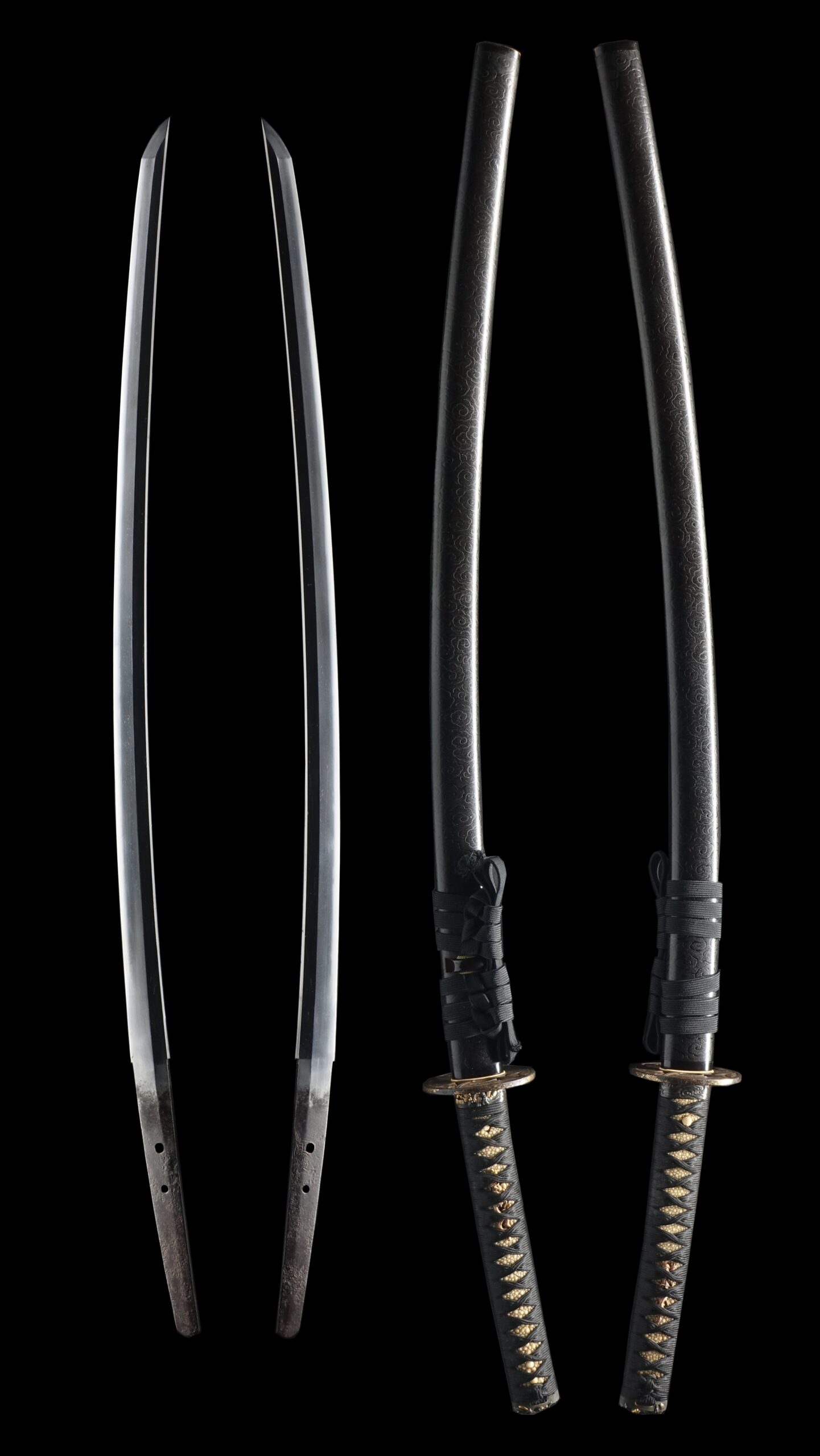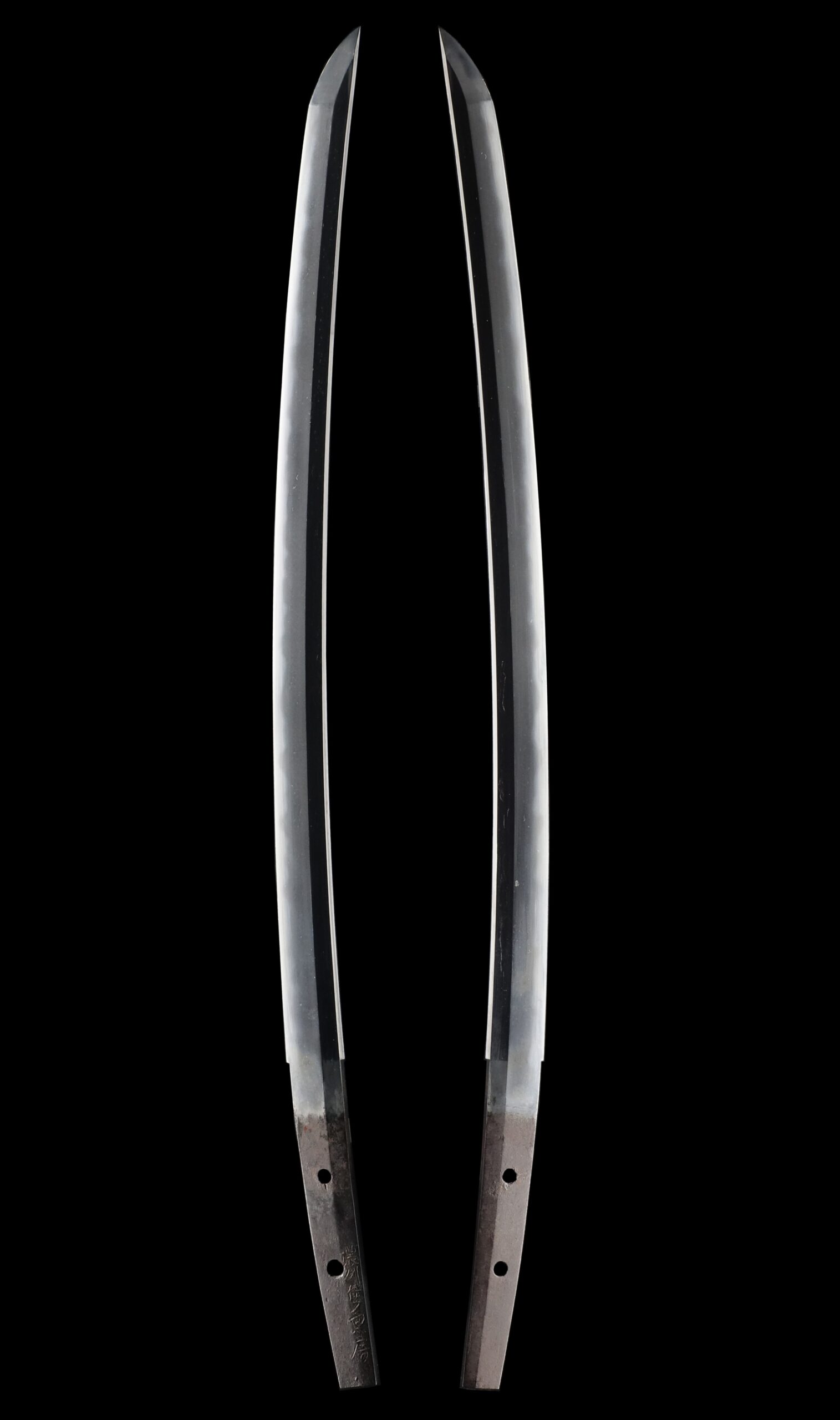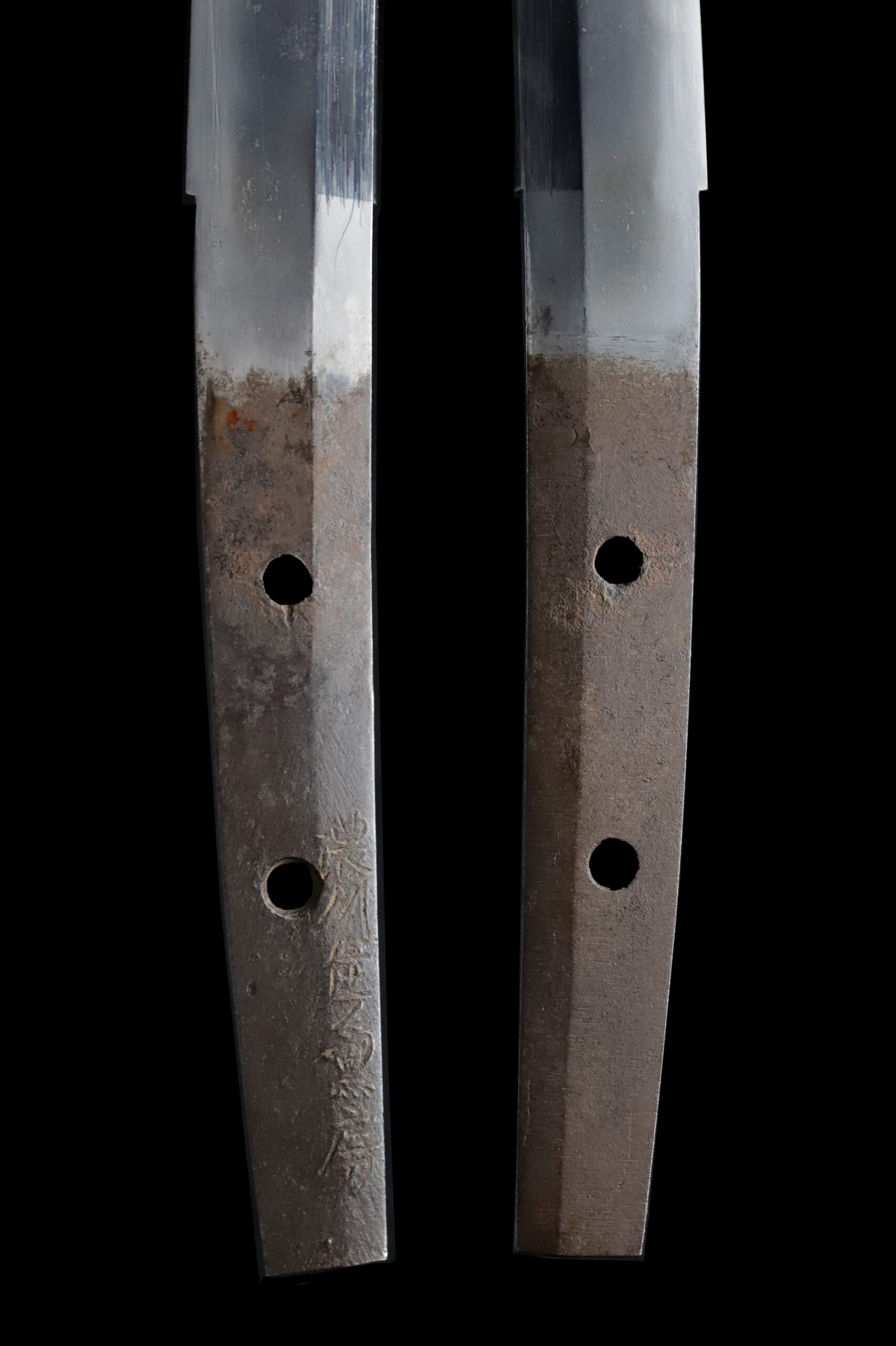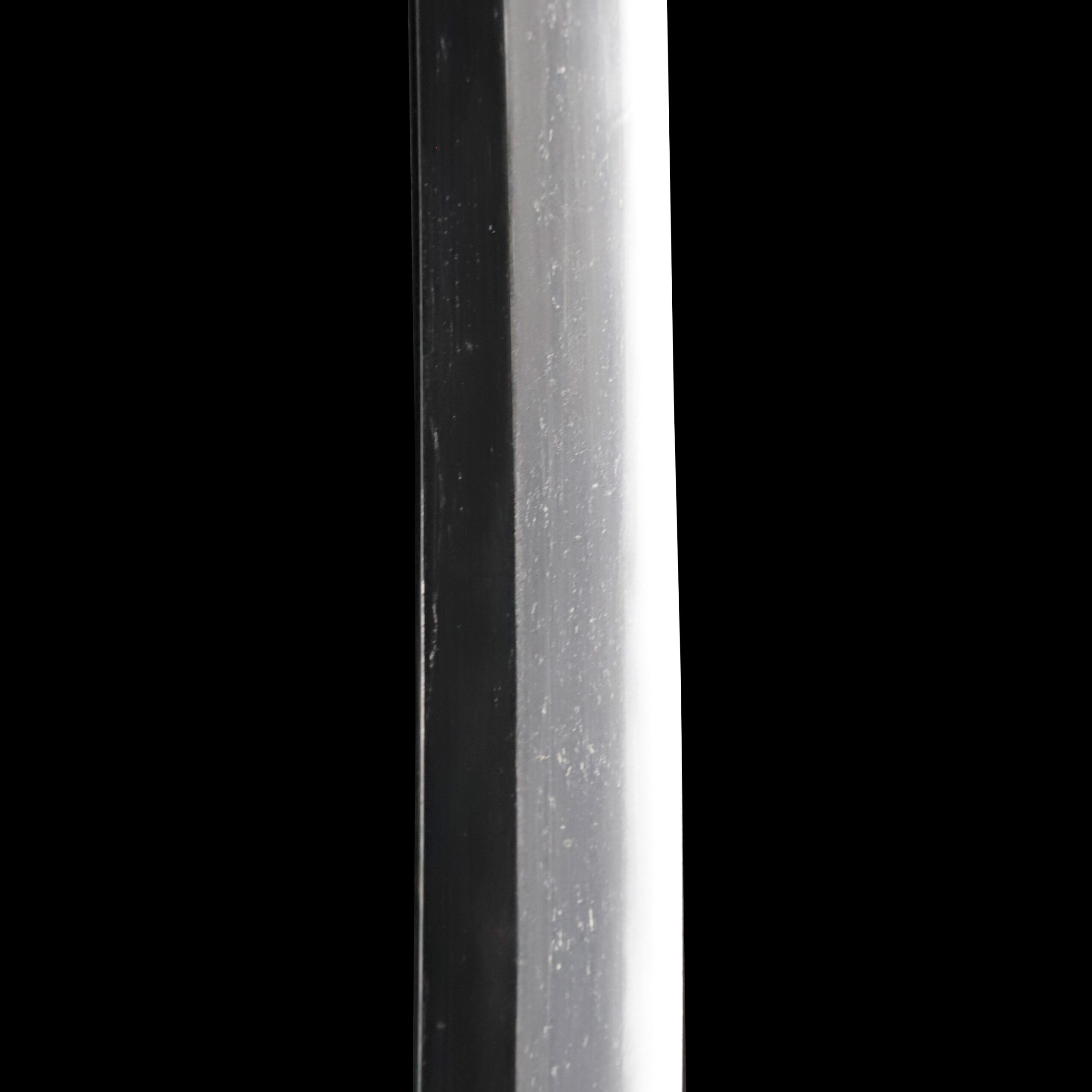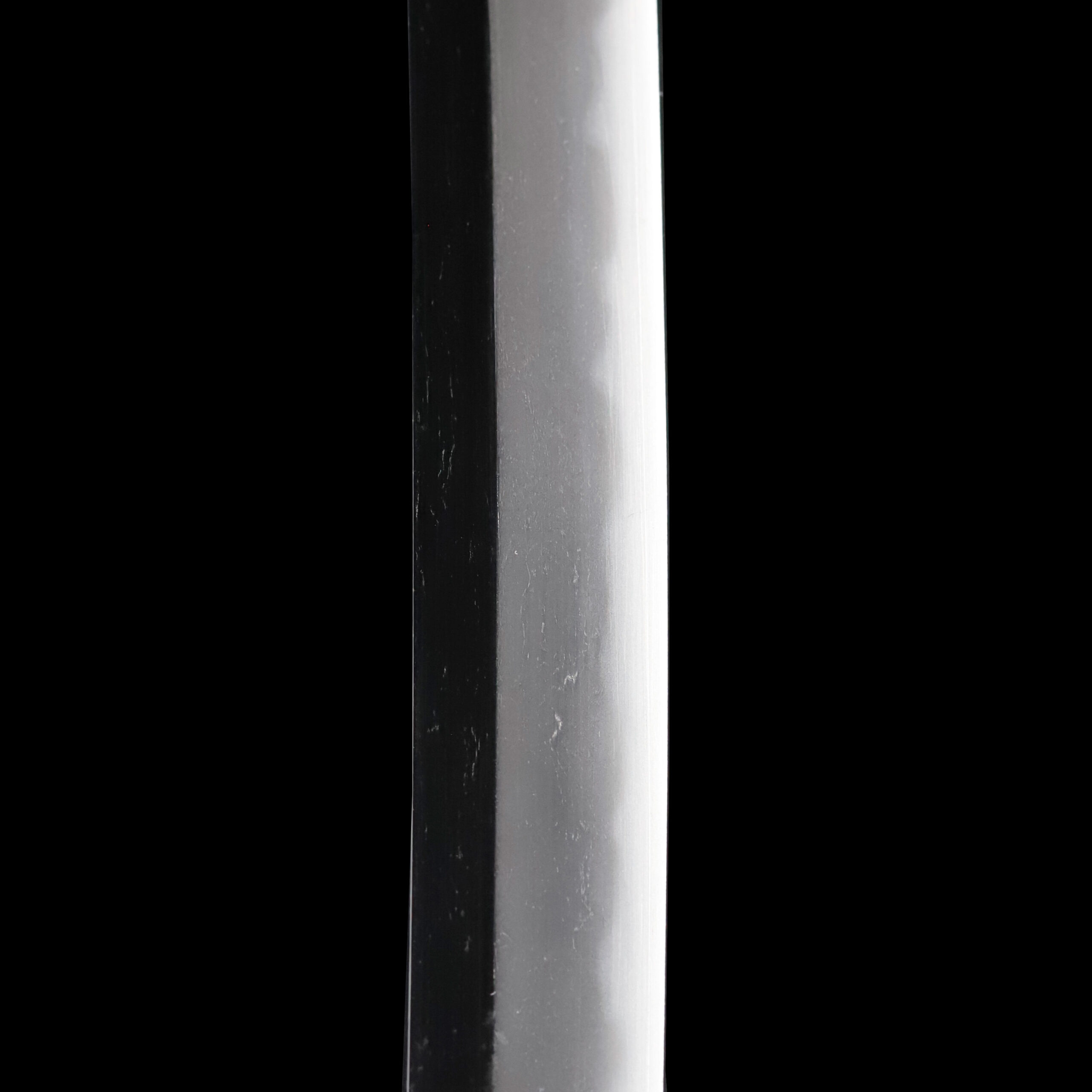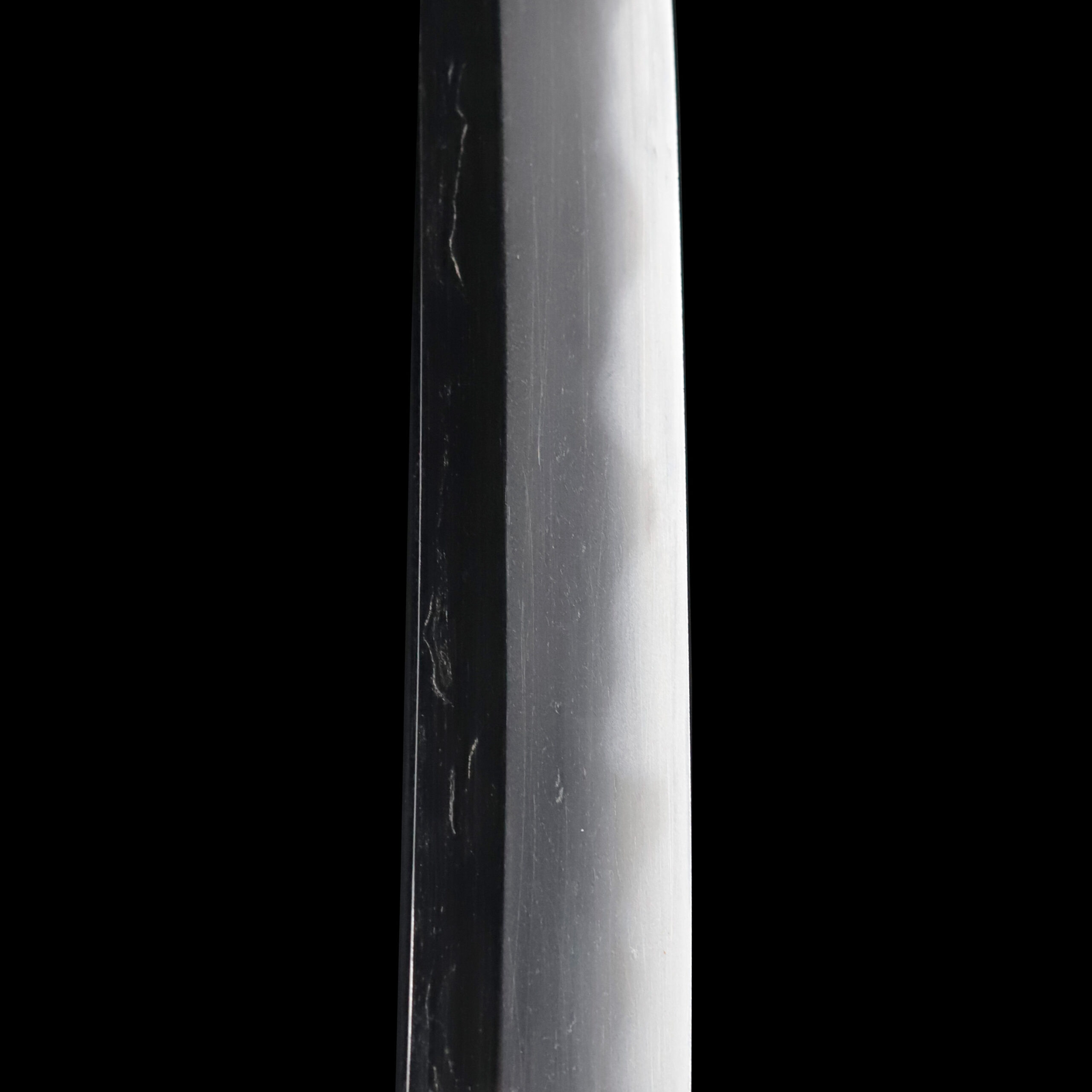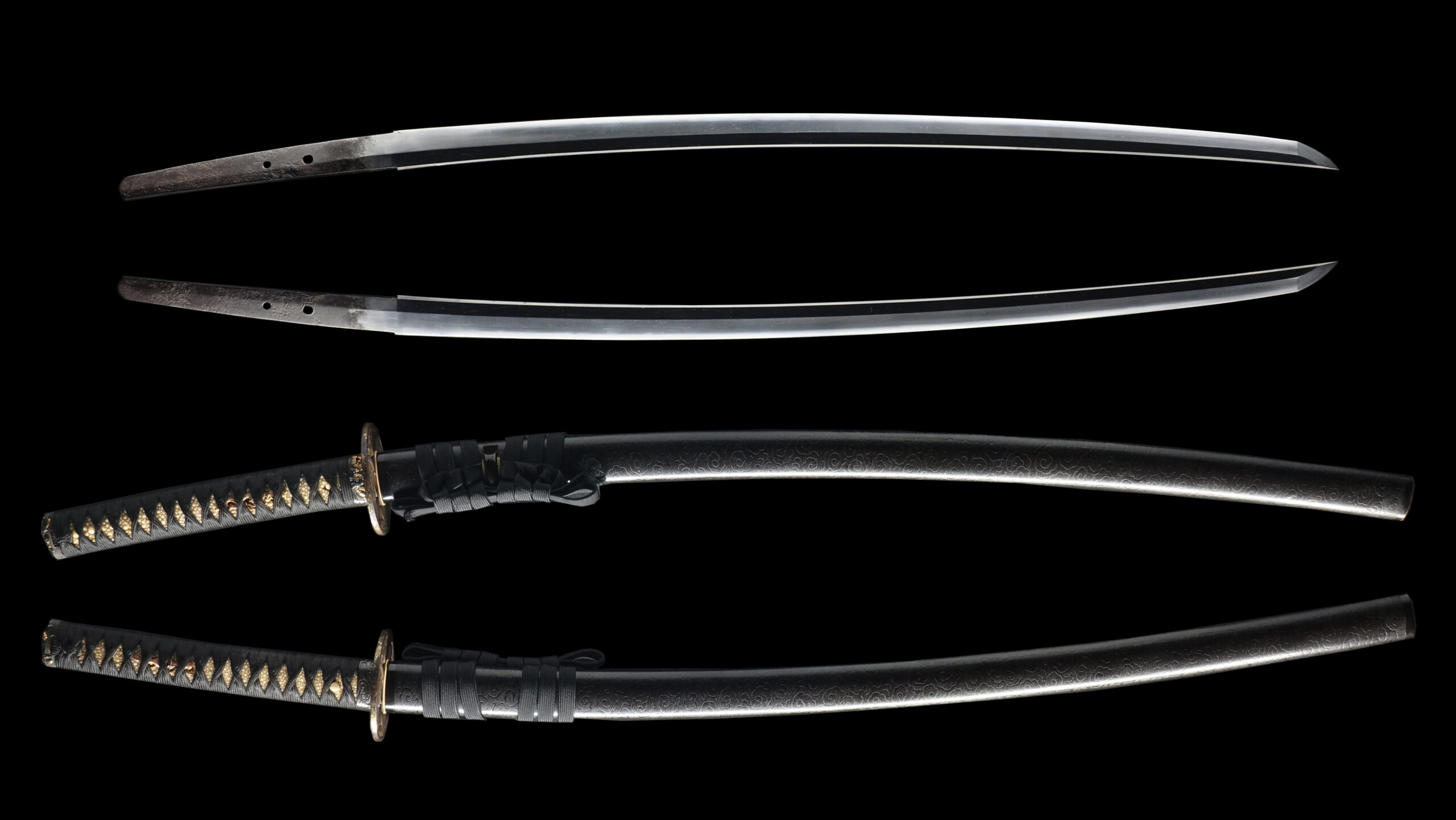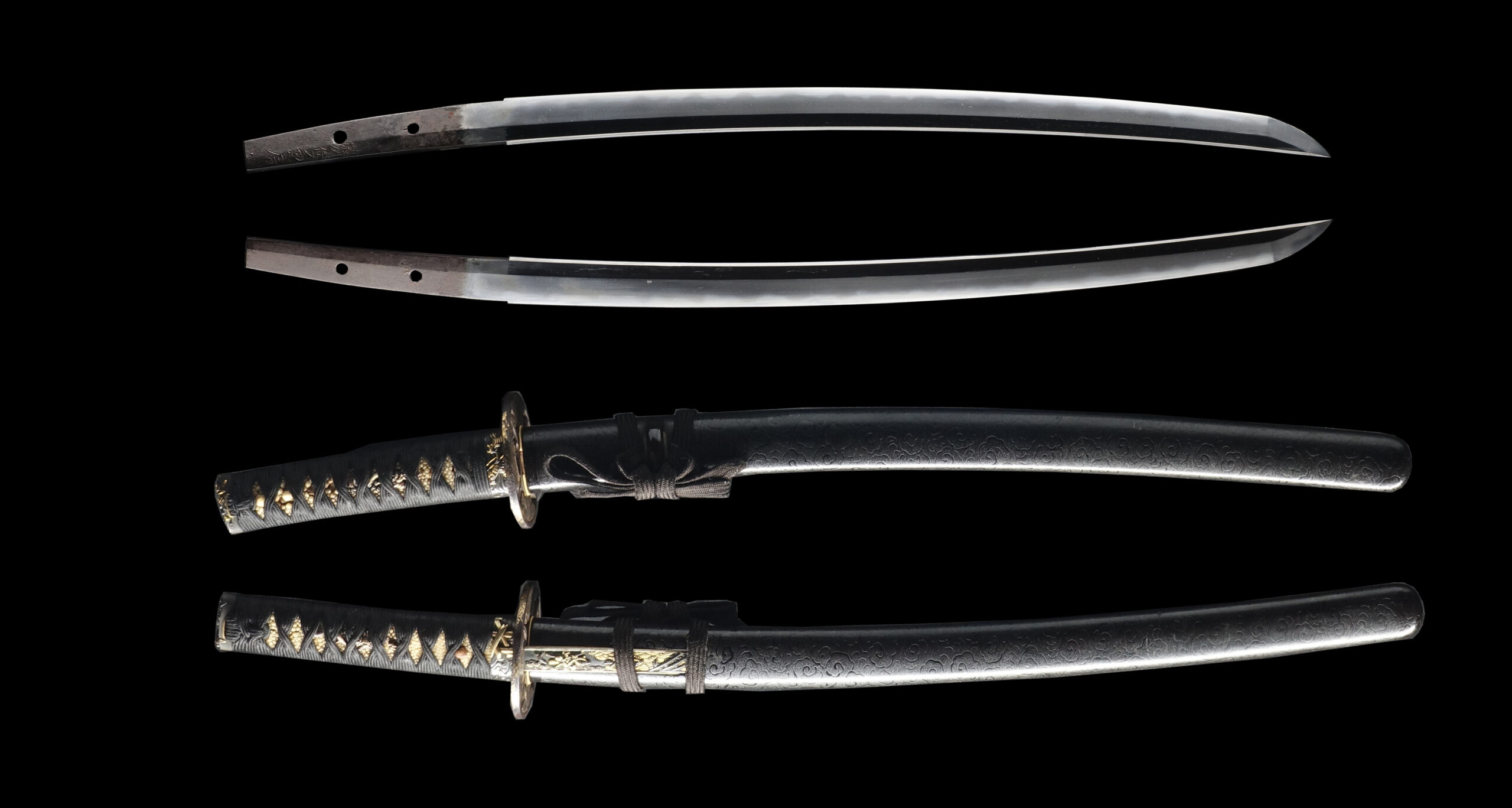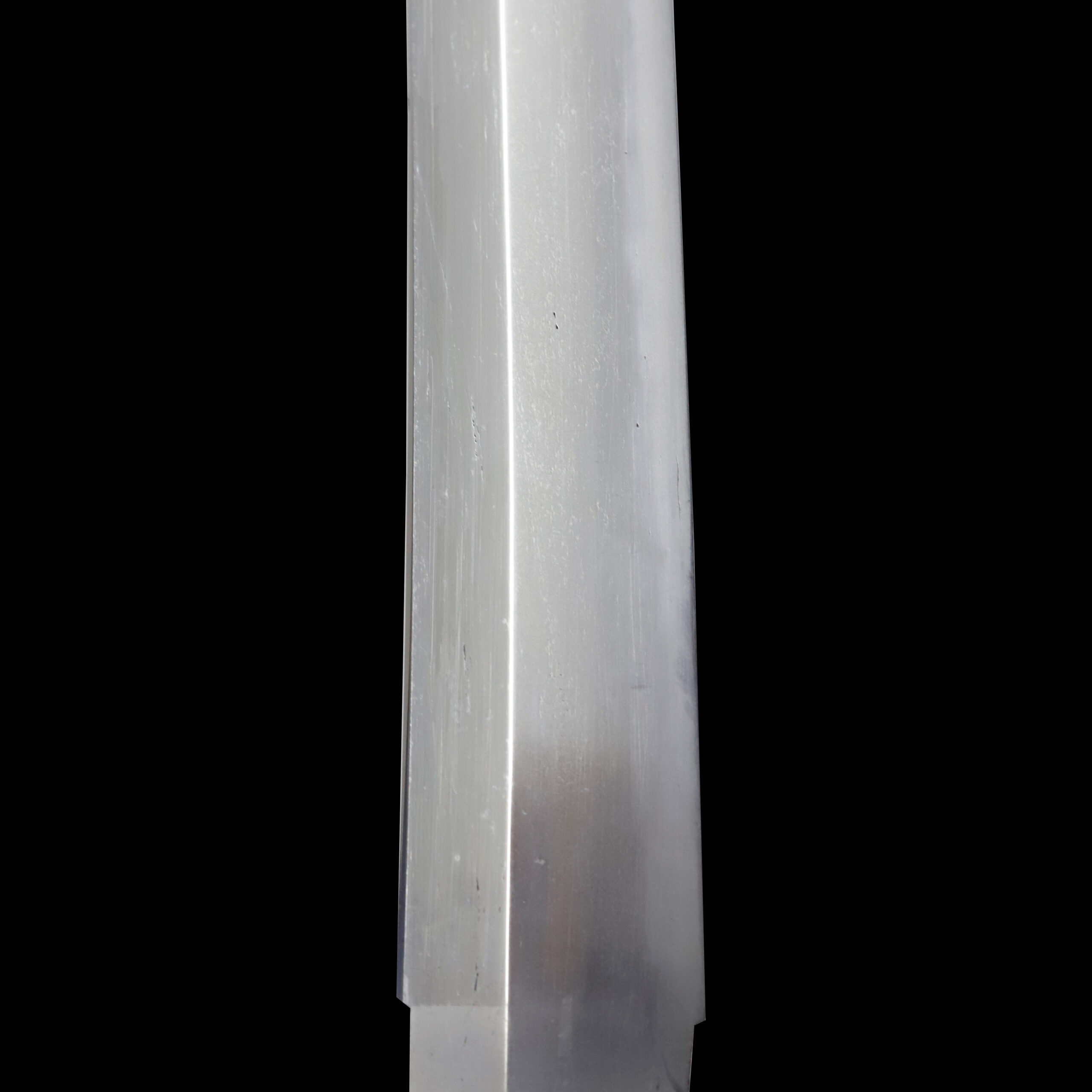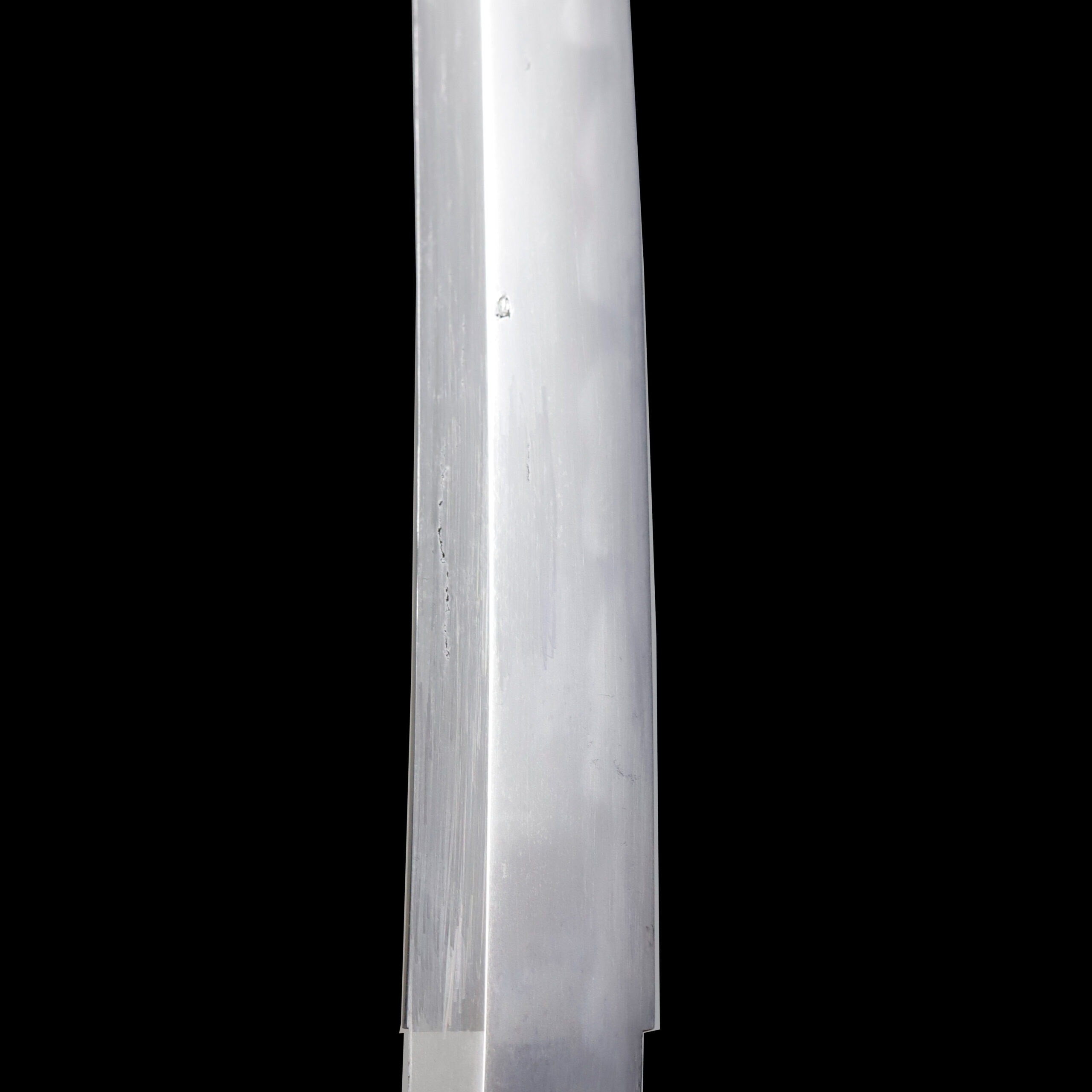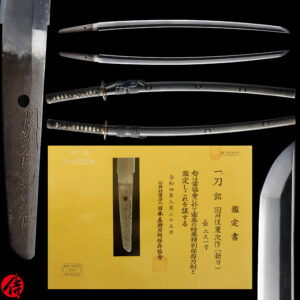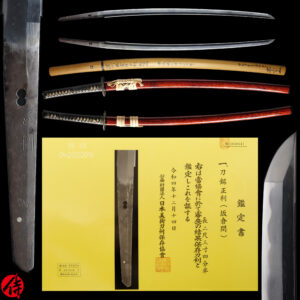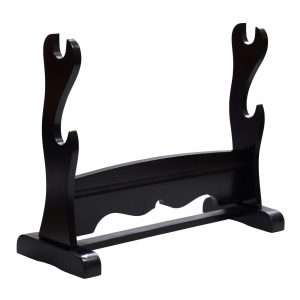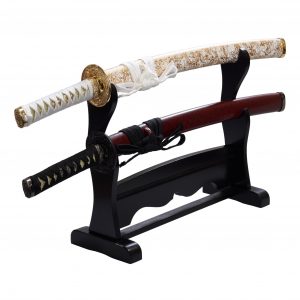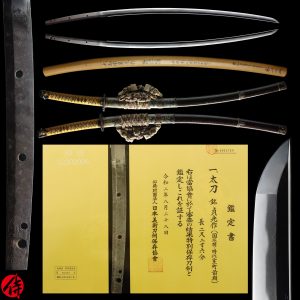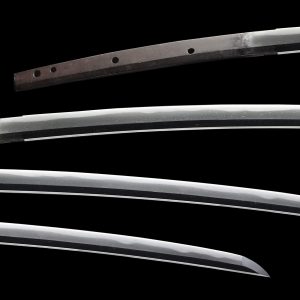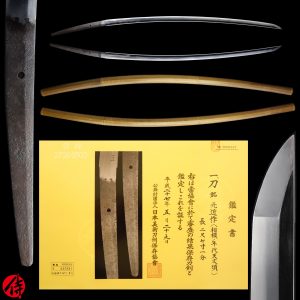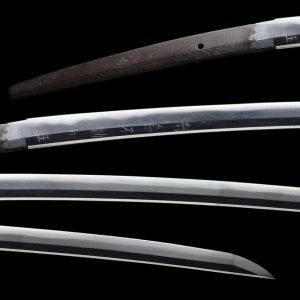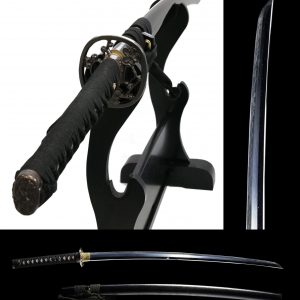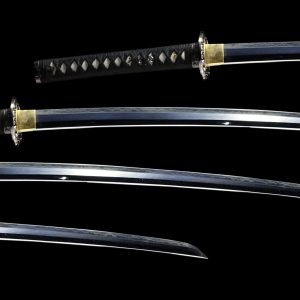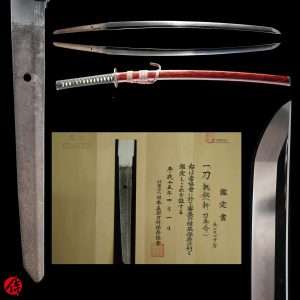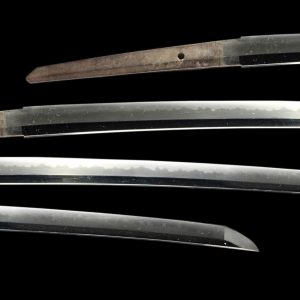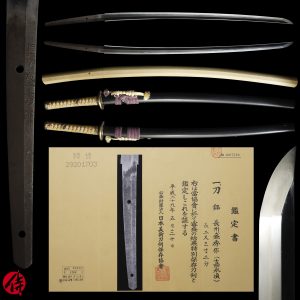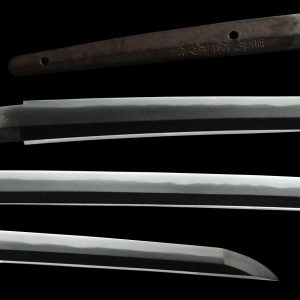Antique Japanese Sword Daisho Signed by Kunitsugu/Kanefusa with NBTHK Tokubetsu Hozon Certificate & Hozon Certificate
【Description】
-Katana
This blade was signed by Kunitsugu (國次) during the Muromachi period, according to NBTHK that appraised this blade. There were a few swordsmiths who used Kunitsugu as their maker’s names. And, NBTHK didn’t specify which Kunitsugu forged this blade. Nevertheless, you can see great sword-forging technique from the Muromachi period.
When this blade was forged, it is possible that Japan was in the warring state called Sengoku Jidai where there were so many rivalry and wars between regional feudal lords. It is possible this blade was owned by a Samurai who participated in one of the warfare back then.
This blade is categorized as a Koto blade. The swords made between the Late Heian Period towards the end of the Warring States (930-1595 A.D.) are called KOTO (古刀: Old-Sword) in Japanese. Those swords were likely to be used in real lives of Samurai, so their designs had to fit the way they used the sword. The blacksmithing technique wasn’t fully developed yet in this era, so the KO-TO blades contain gold, silver, and other metals, making the surface pattern of Koto intricate and beautiful.
Based on the characteristic of the blade and where the signature is located, NBTHK authenticated it a a Tachi blade. Tachi was mainly used by an armored Samurai with one hand on horseback from the Heian period (794-1185 A.D.) until the early Muromachi period. TACHI was suspended loosely on the left waist with its edge facing the ground so that you could draw it faster to cut down soldiers on the ground. It is stored in a Katana style Koshirae now.
-Wakizashi
This blade was signed by Noshu Jyu Kanefusa (濃州住兼房). Noshu is another name for Mino province (Today’s Gifu prefecture). Noshu Jyu means that Kanefusa resided in this area when he forged this blade. The maker’s name, Kanefusa, lasted a few generations during the Muromachi period. We believe this blade was made by the late-gen Kanefusa in the late Muromachi period (early-mid 16th century) based on its characteristic and NBTHK appraisal.
The first-gen Kanefusa was active during the Eikyo era (1429-1441: mid-Muromachi period), and he was known as the son of Kaneshige, who belonged to Yoshisada school in Seki city. In Mino province, Seki City was the most active sword-forging site. And the first-gen Kanefusa was famous for inventing a particular Hamon (tempering line) called Kenbo Midare (兼房乱れ).
The swordsmiths who resided in Mino province developed particular sword-forging tradition called MINO-DEN. Its characteristic is the TOGARI(Pointed shapes protruding from the Hamon ) in a classic straight line and random temper line with some white Utsuri. MINO-DEN had its origin from YAMATO-DEN in the late KAMAKURA period(1280-1330). It flourished in the MUROMACHI period(1333-1573) and continued until the EDO period(1603-1868).
MINO-DEN especially prospered during Sengoku Jidai(Warring State period) due to the high demand for weapons. And the location of Mino province beat others. Akechi Mitsuhide controlled Mino province, and Nobunaga Oda ruled Owari province, and Tokugawa Ieyasu was the lord of Suruga (Neighboring areas). There was high demand from those powerful feudal lords and their retainers. Furthermore, so many wars occurred between the Kanto region and the Kyoto area. Mino was located in the middle, making feudal lords feel convenient to order swords from MINO-DEN. The blades forged in MINO provinces also had the reputation of its practical design and sharpness. Many feudal lords demanded swords forged in the Mino province.
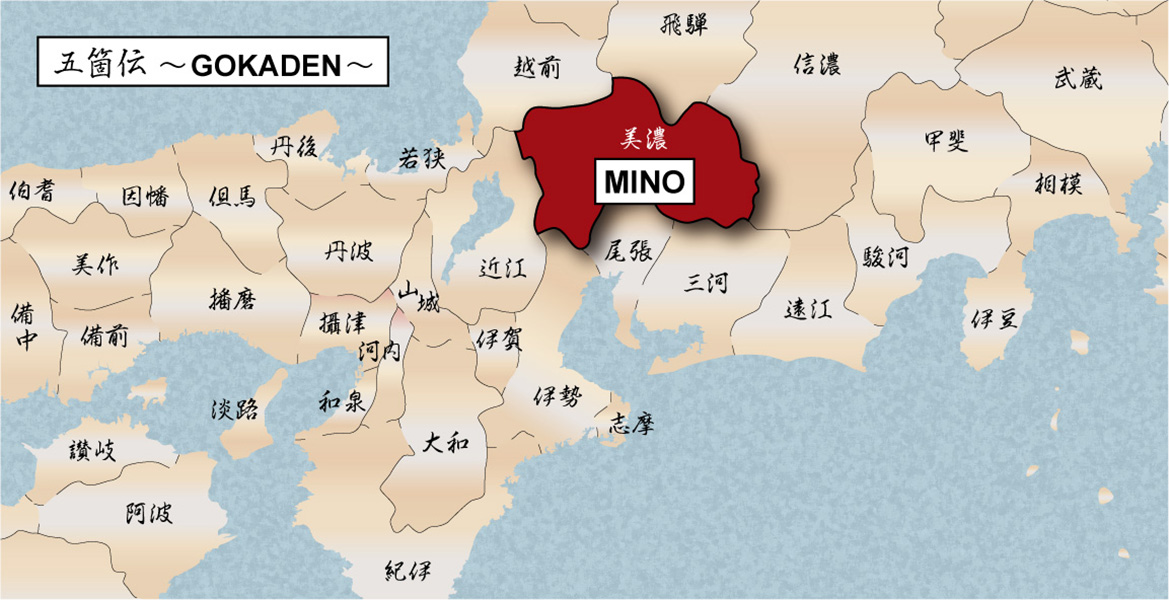

What is Daisho?
Daisho is a pair of two Japanese swords Samurai carried. During the Edo period, having Daisho in public places was considered social status for Samurai. Furthermore, Samurai were required to wear them under the law back then. Daisho is written as 大=Big and 小=Small. Dai part means Katana, and Sho part means Wakizashi. We are confident you would find this pair of Daisho gorgeous. They have such a fancy appearance that we believe a high-ranked Samurai owned them.

Appraisal
This Katana blade is appraised as a Tokubetsu Hozon Token(特別保存刀剣) and this Wakizashi is appraised as a Hozon Token (保存刀剣). They were issued by NBTHK(Nihon Bijutsu Touken Hozon Kyokai:日本美術刀剣保存協会). These authentication papers were only given to authentic Japanese swords well preserved and high quality with artistic value.
*Please keep in mind that there are is a couple of tiny Kitae Kizu on the Katana and Wakizashi. If you like to see the detailed condition, please feel free to contact us.
【 Blade】
-Katana
Cutting Edge Length(Nagasa):67.0 cm ( 26.4 inches)
Curvature(Sori):1.85 cm (0.73 inches)

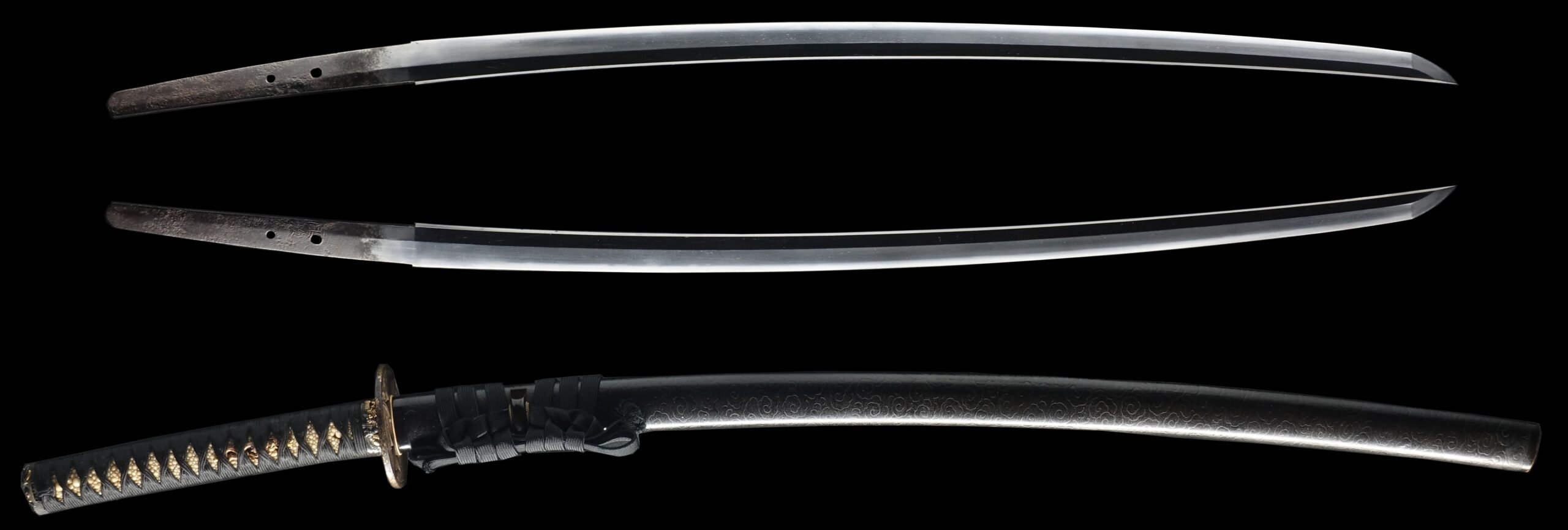
-Wakizashi
Cutting Edge Length(Nagasa): 46.8 cm ( 18.4 inches)
Curvature(Sori):1.2 cm ( 0.47 inches)

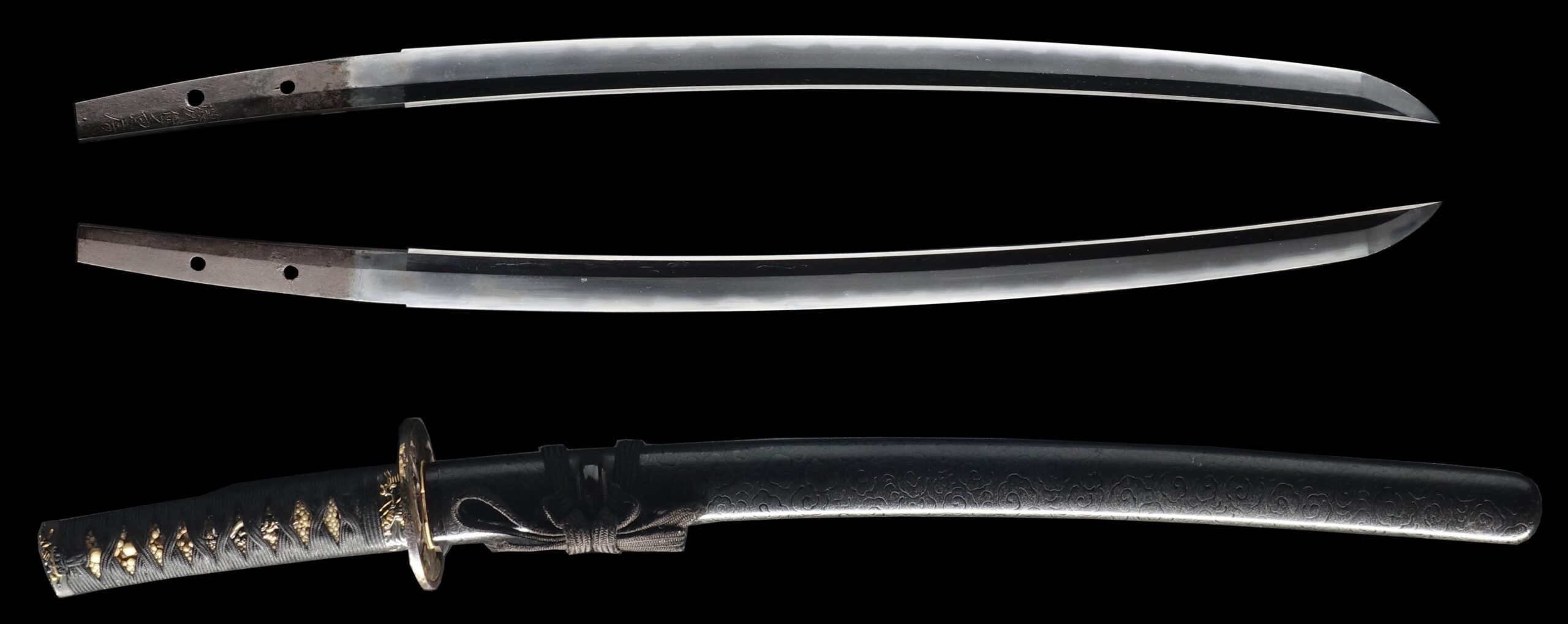
Hamon:
The crystalline structure which forms along the cutting edge of a blade as a result of the hardening process
Jimon(Jihada):
visible steel surface pattern created by folding and hammering during forging process
-Katana
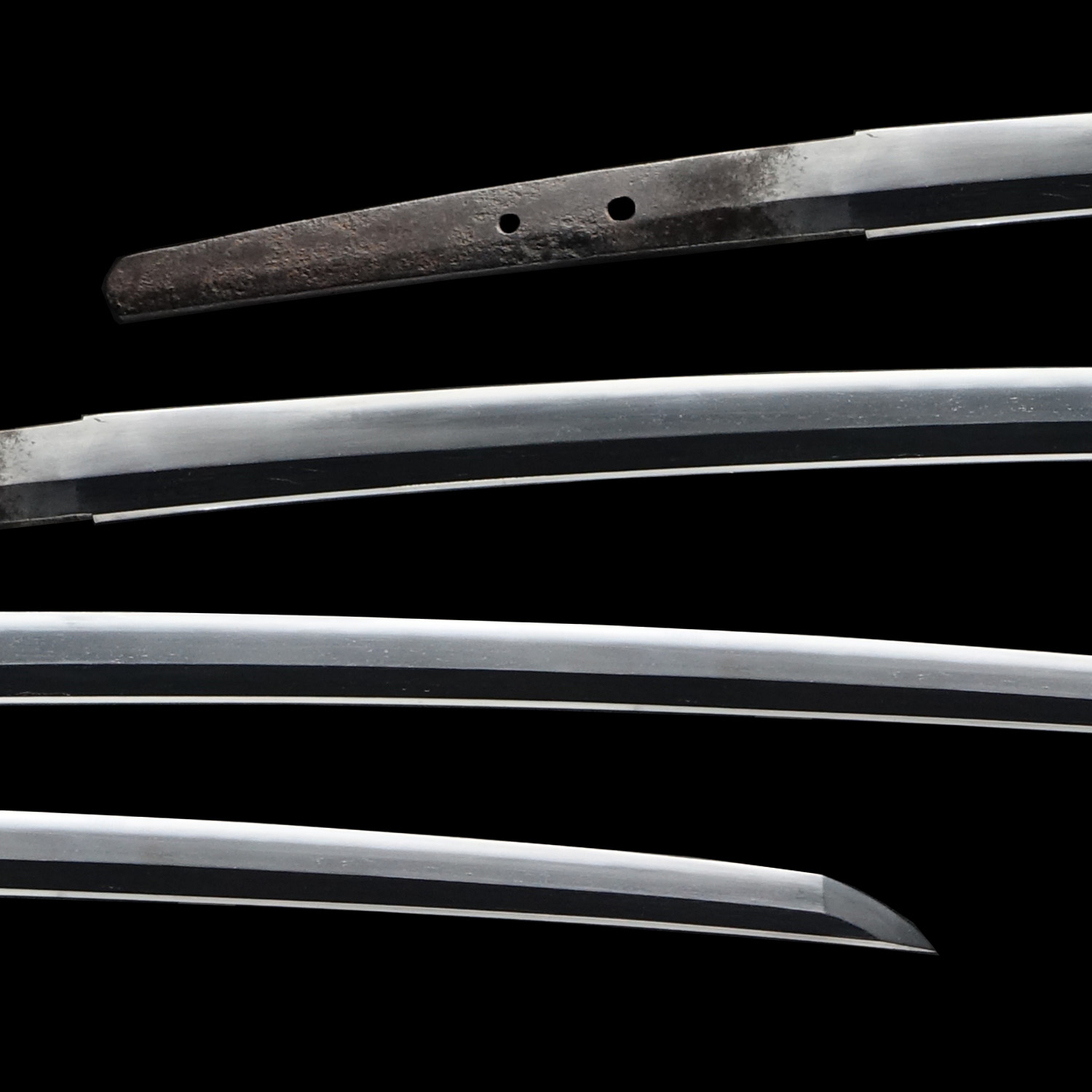
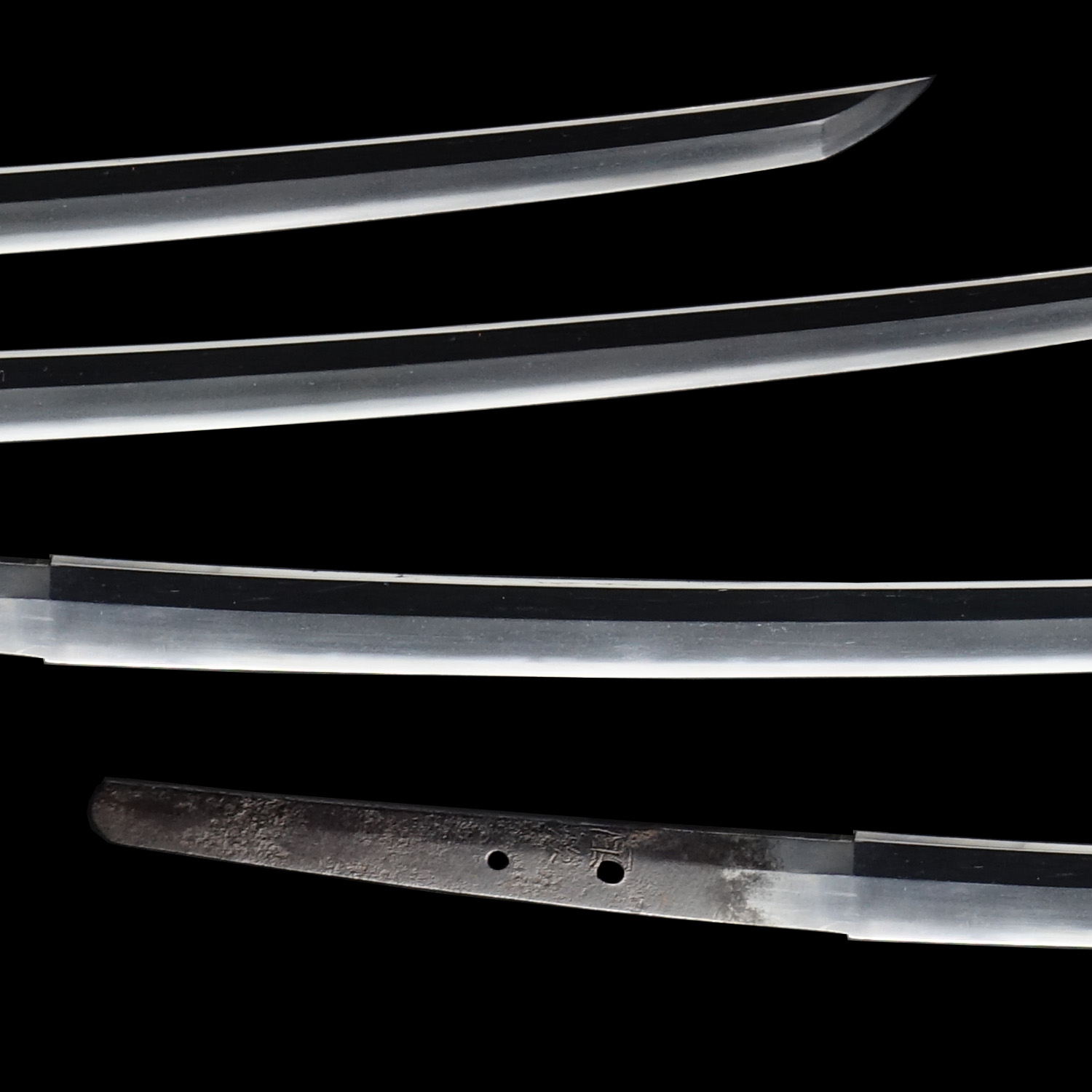

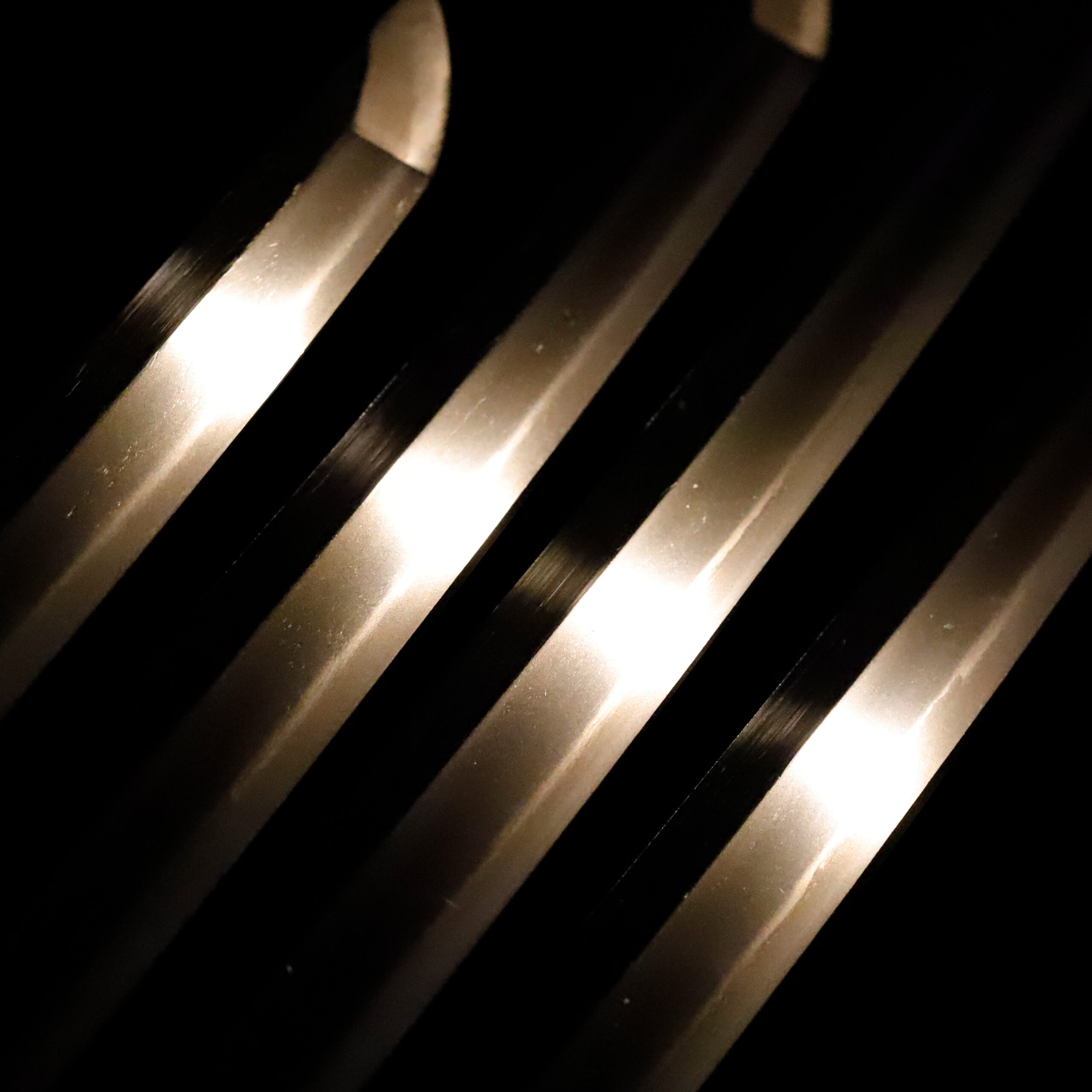
-Wakizashi

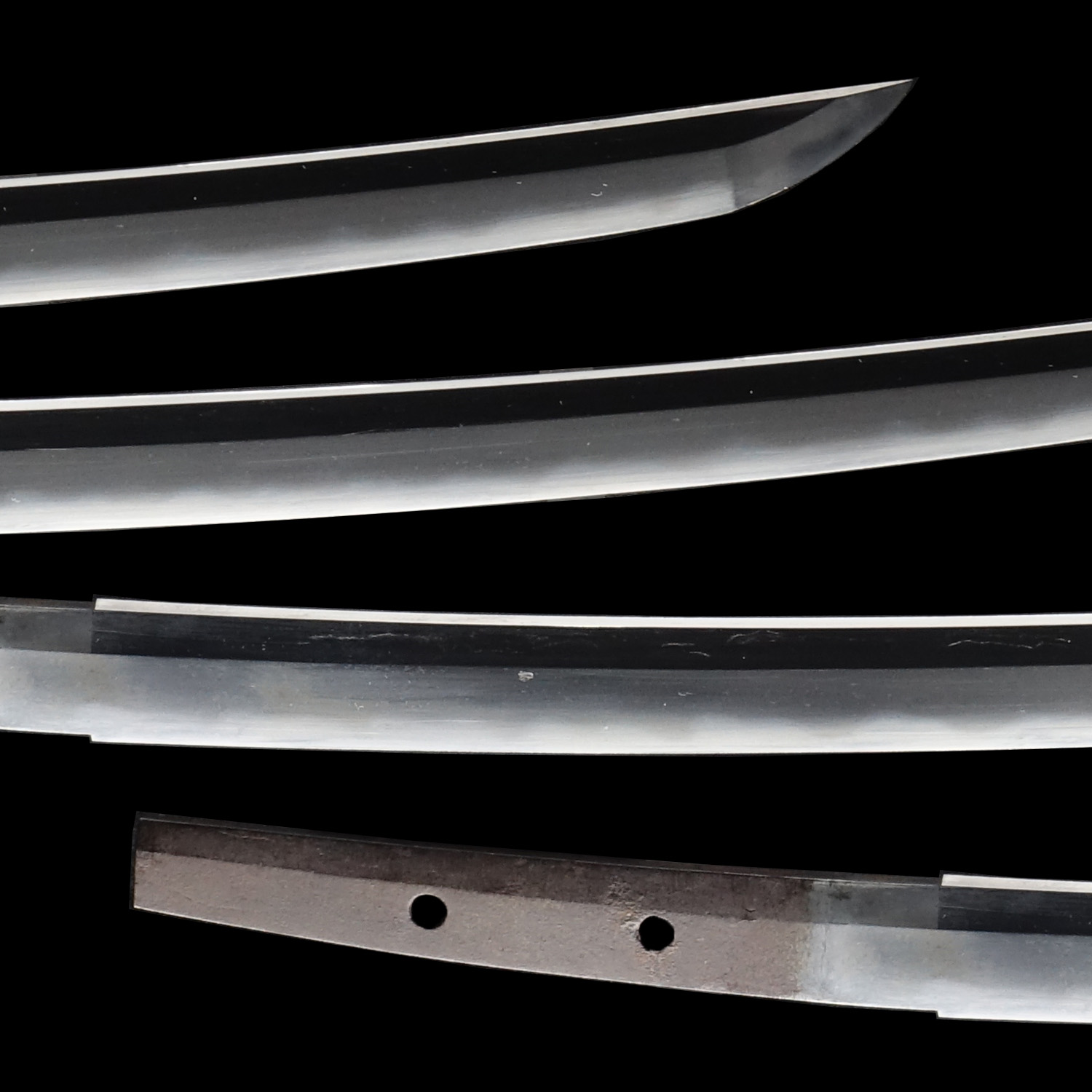
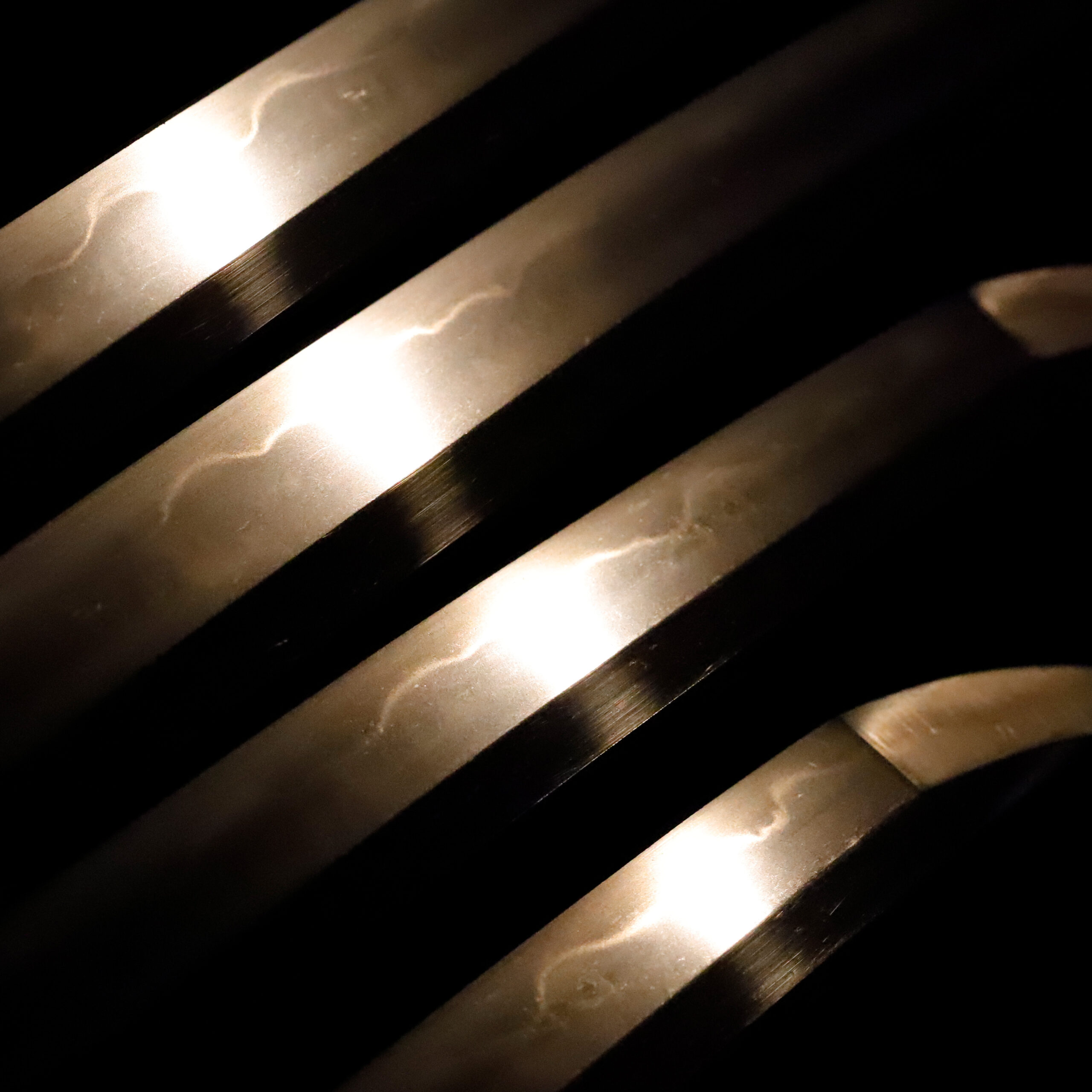
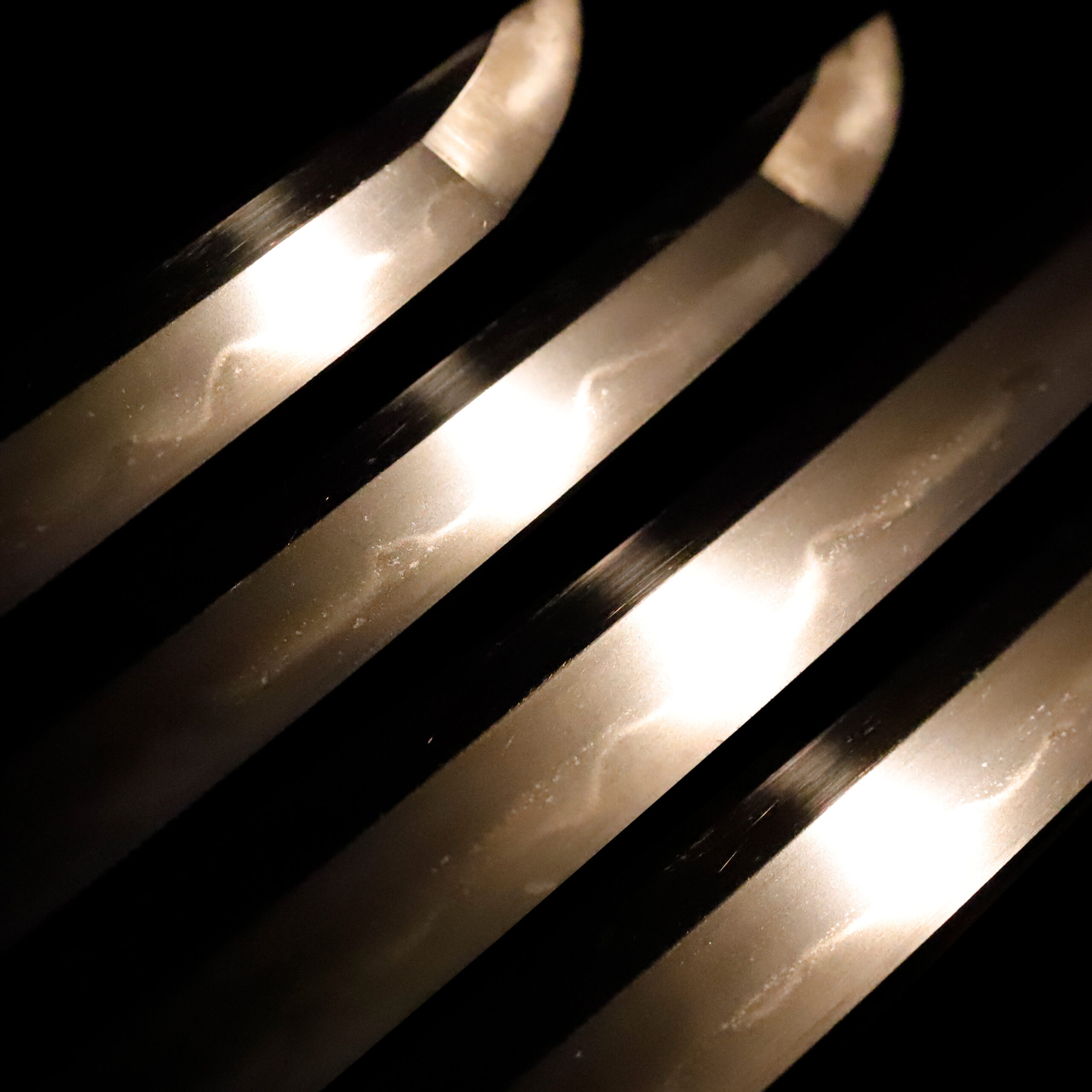
Nakago:Nakago is the tang of the Japanese sword.
Japanese swordsmiths left the black rust on the tang because it prevents red rust while the tang is in its handle. And the discoloration of the tang was created over time, and it is a great indicator for a Japanese sword specialist to estimate when the sword was forged.
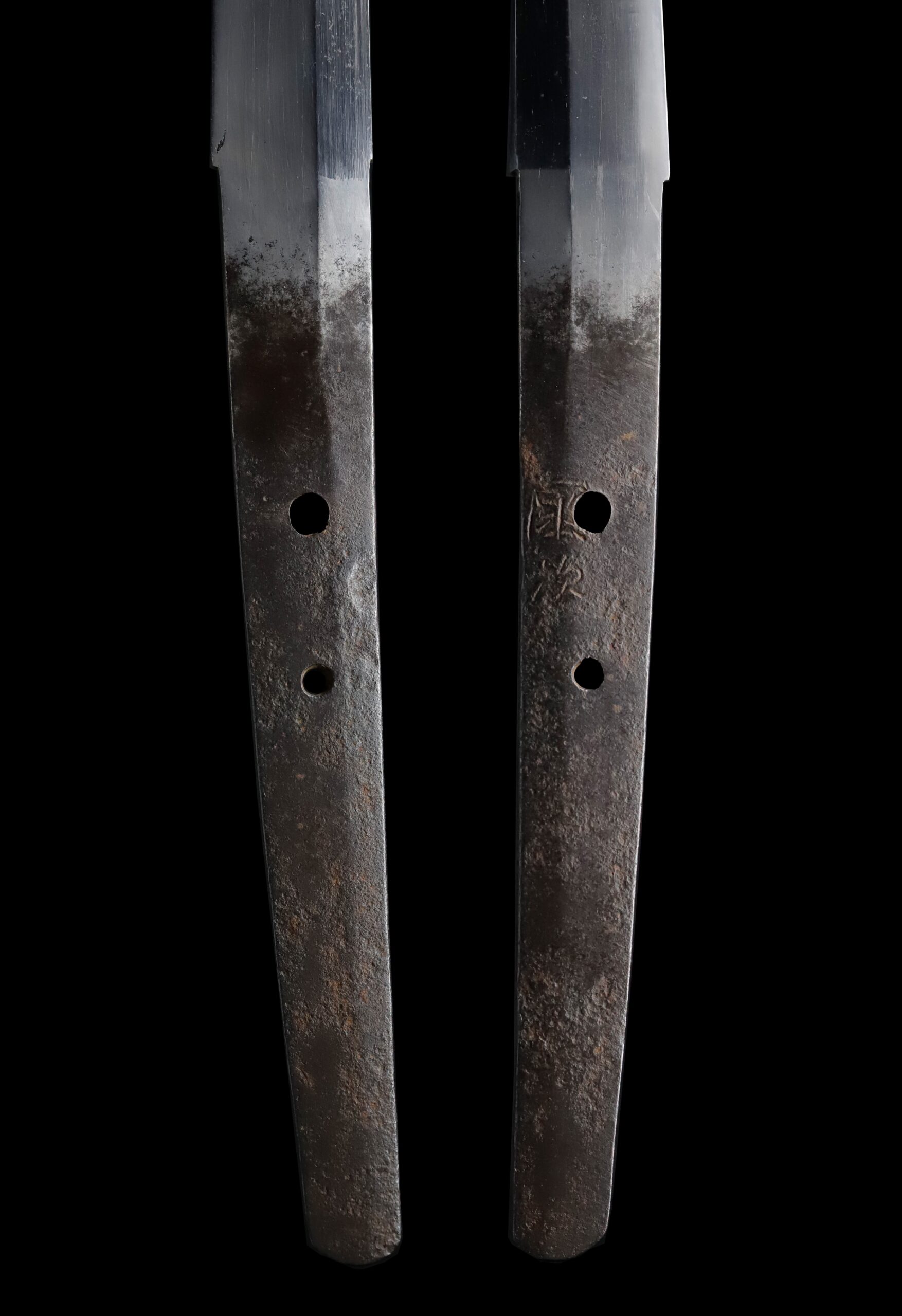
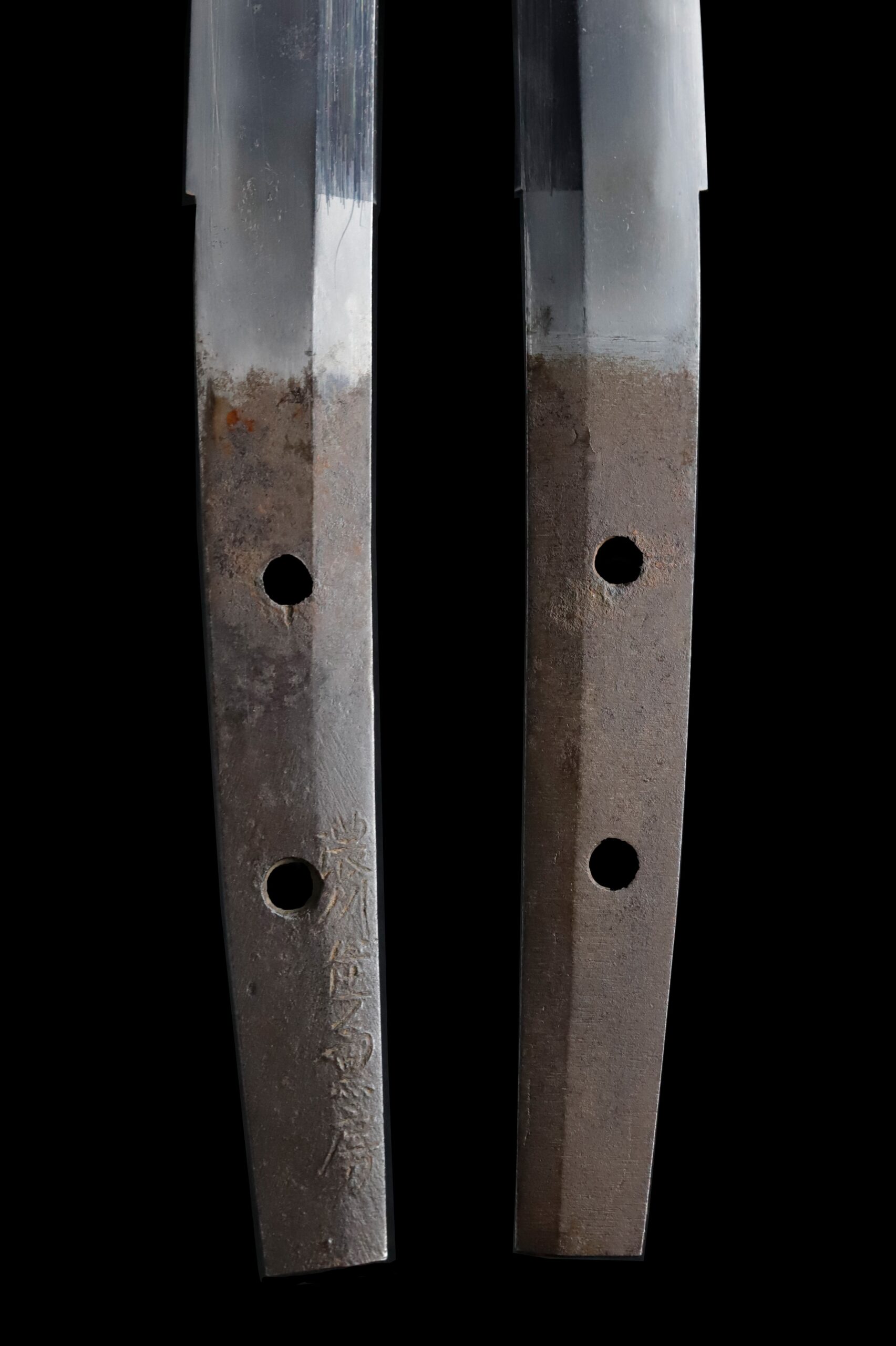
Koshirae: Koshirae is the mounting of the Japanese sword. There are several parts that consist of Koshirae such as Saya(Sabbard), Tsuka( Handle), Tsuba(Handguard).

Fuchi-Kashira:A pair of matching sword fittings that cover the upper and bottom parts of its sword hilt.
Both Fuchi Kashiras were designed with the same theme. A Samurai riding a horse is engraved on each Kashira part, and the Fuchi parts depict the scenery of battle at the waterside. The Samurai on the back of a horse with bows and arrows has a terrifying expression, and it is a powerful expression that makes us feel as if they are about to jump out into the real world with the horse at any moment. The same thing is true for the Samurai warriors fighting on the waterfront, and this is also depicted so realistically that we could almost hear their voices and the sound of swords clashing. We would like to categorize these Fuchi Kashiras’ design themes in one of the Kassen Zu (合戦図).
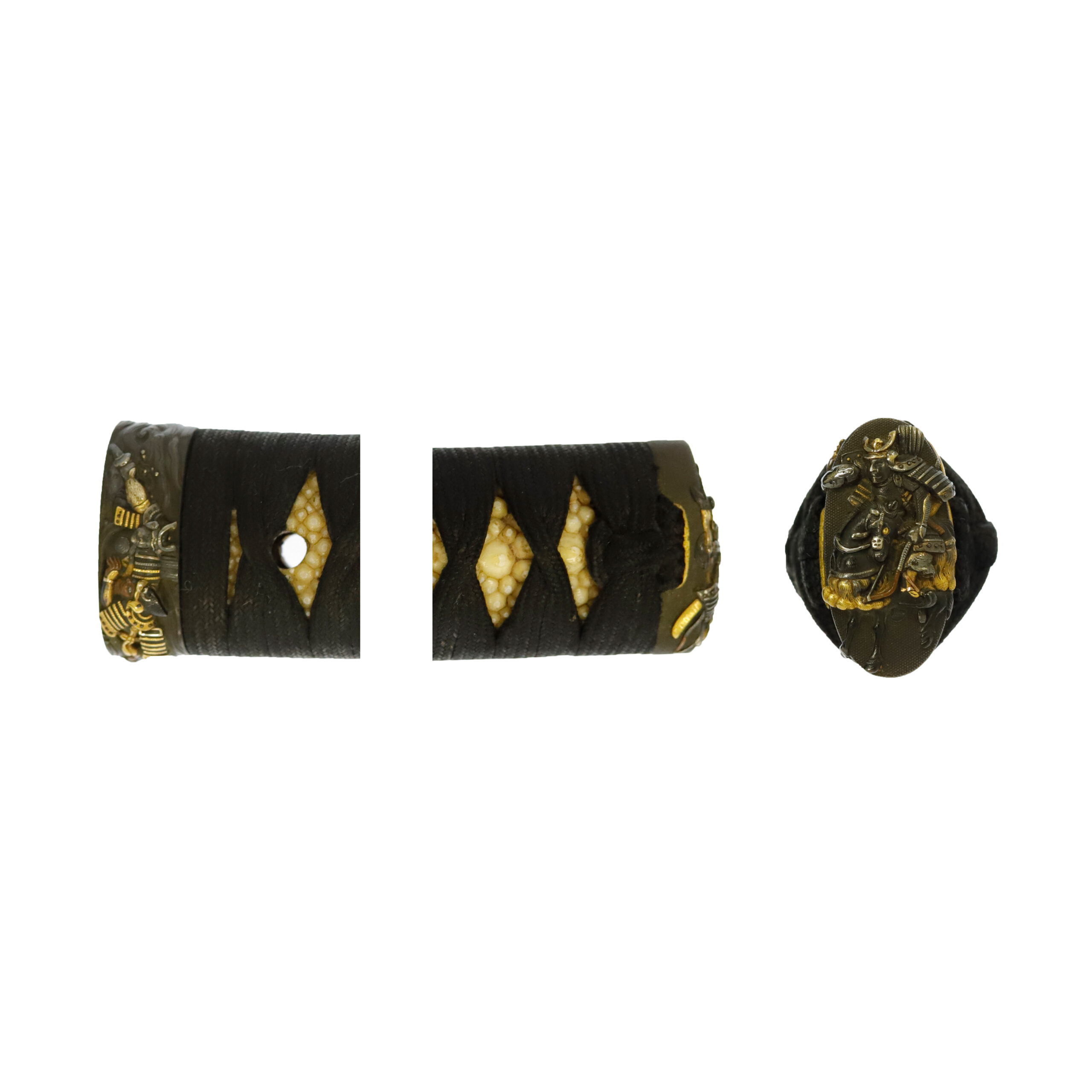
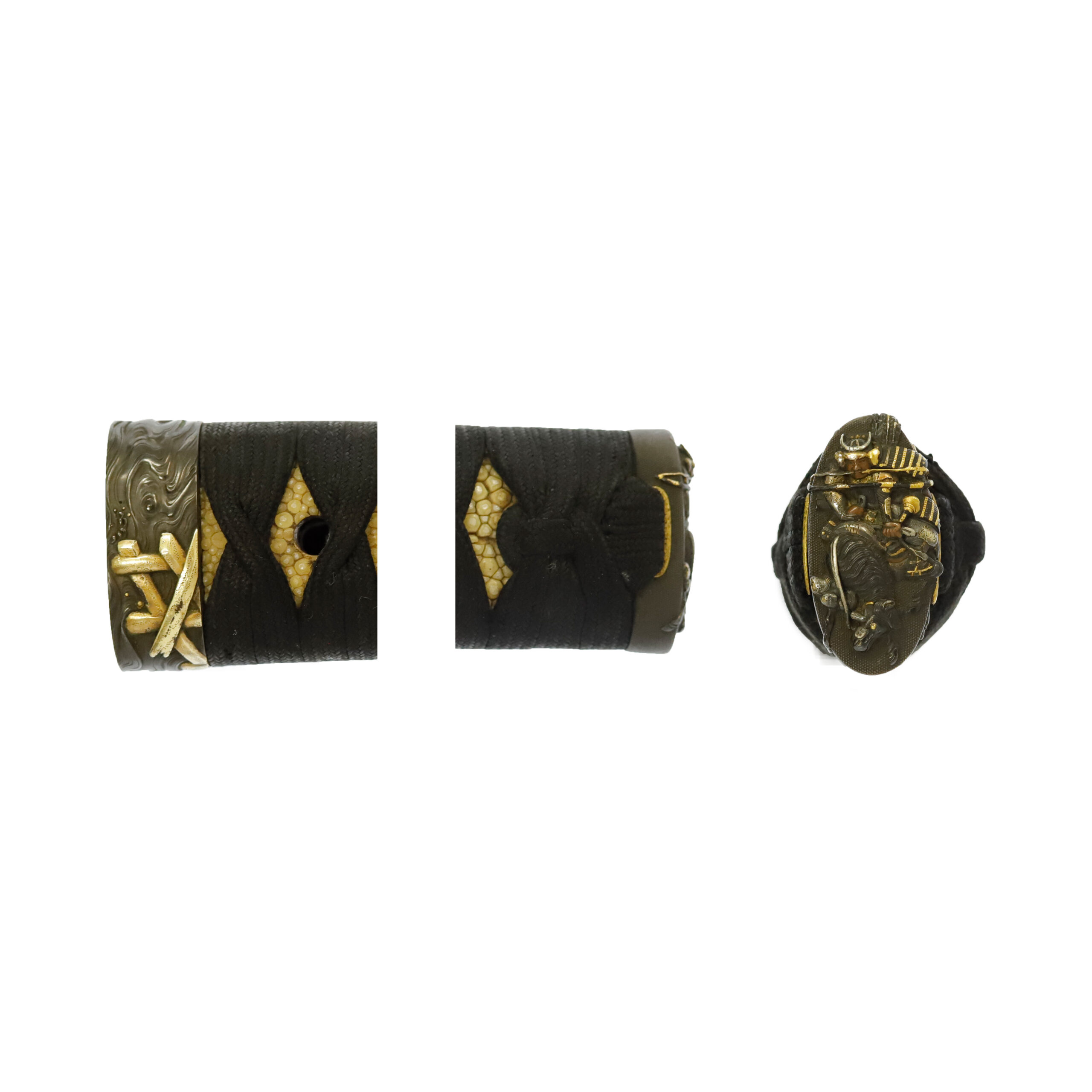
Tsuka and Menuki:Tsuka is the handle of the Japanese sword and Menuki is its decoration.
On each handle, you would find the figure of a dragon through the gaps of the Tsukamaki thread. The details are carefully carved, and it seems as if they represent real animals. Initially, the dragon was an imaginary creature found in ancient foreign traditions or myths. Furthermore, it is regarded as a symbolic beast of auspicious signs. Its body is likened to nine animals: antlers are deer, the head is a camel, eyes are demons, the neck is a snake, the belly is the Mizuchi (蛟, a mythical animal in Japan that looks like a snake and has a horn and four legs), scales are fish, claws are falcons, palms are tigers and ears are cows. It was thought that the dragon would reign at the top of all animals because of its odd-looking appearance.
If you focus on these dragons’ hands, you will find that some of these dragons bring a ball-shaped object in their hand. It is the Nyoi Houju (如意宝珠, Cintāmaṇi), a fantasy jewel that fulfills any desire and gives out treasure, clothes, food, and drinks. Moreover, it heals illness and suffering, removes evils, purifies muddy water, and prevents disasters. It is said this magical item is taken from the brain of the dragon king.
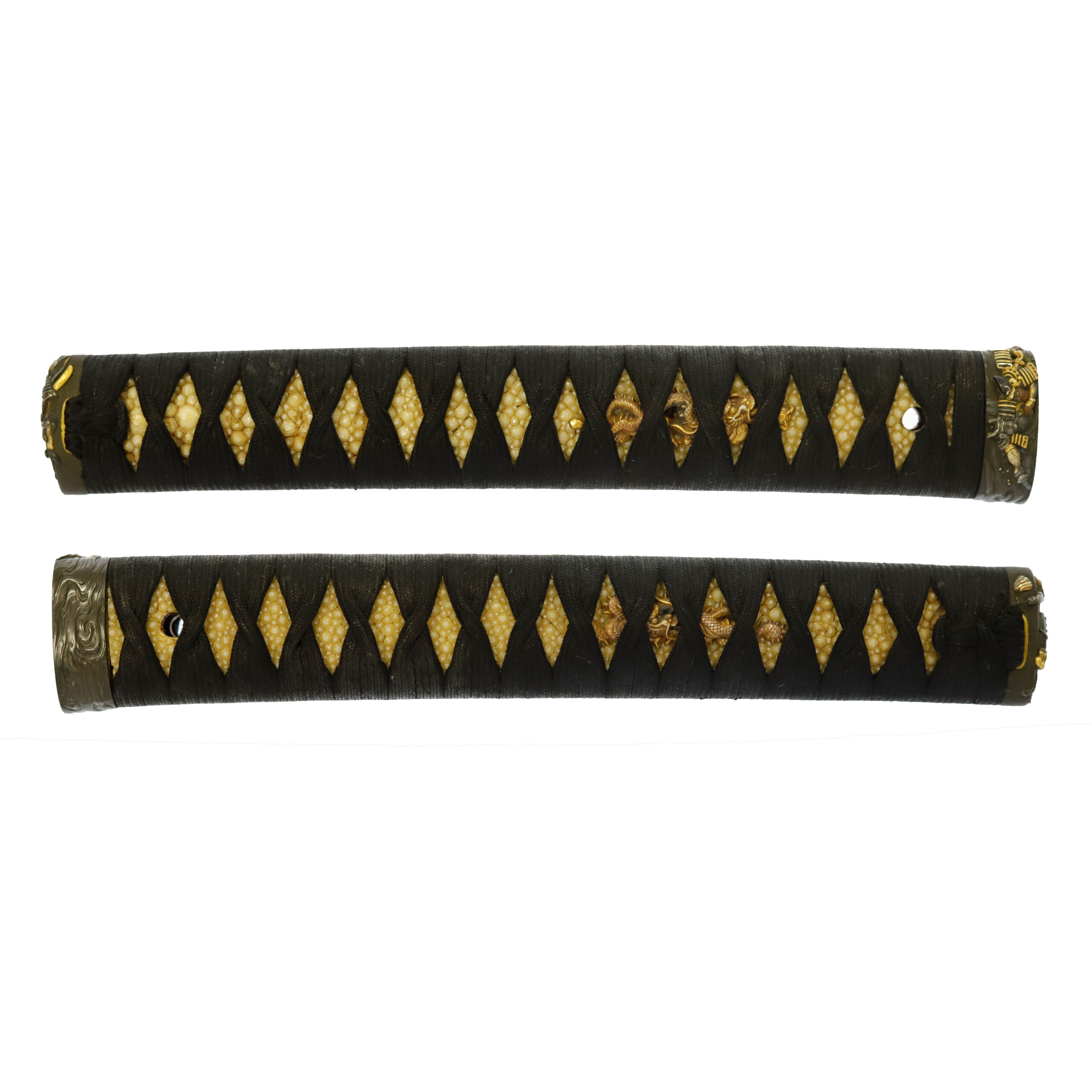
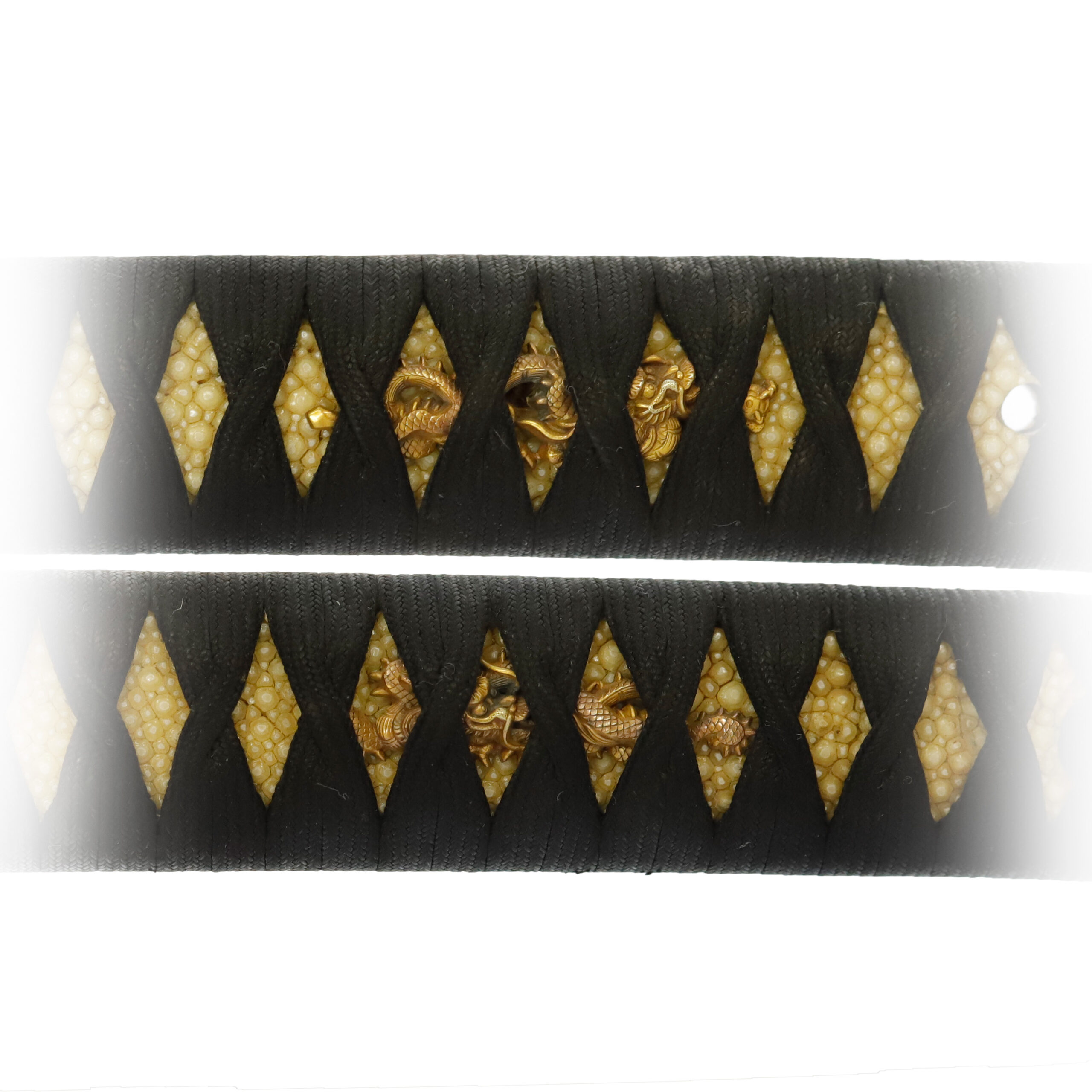

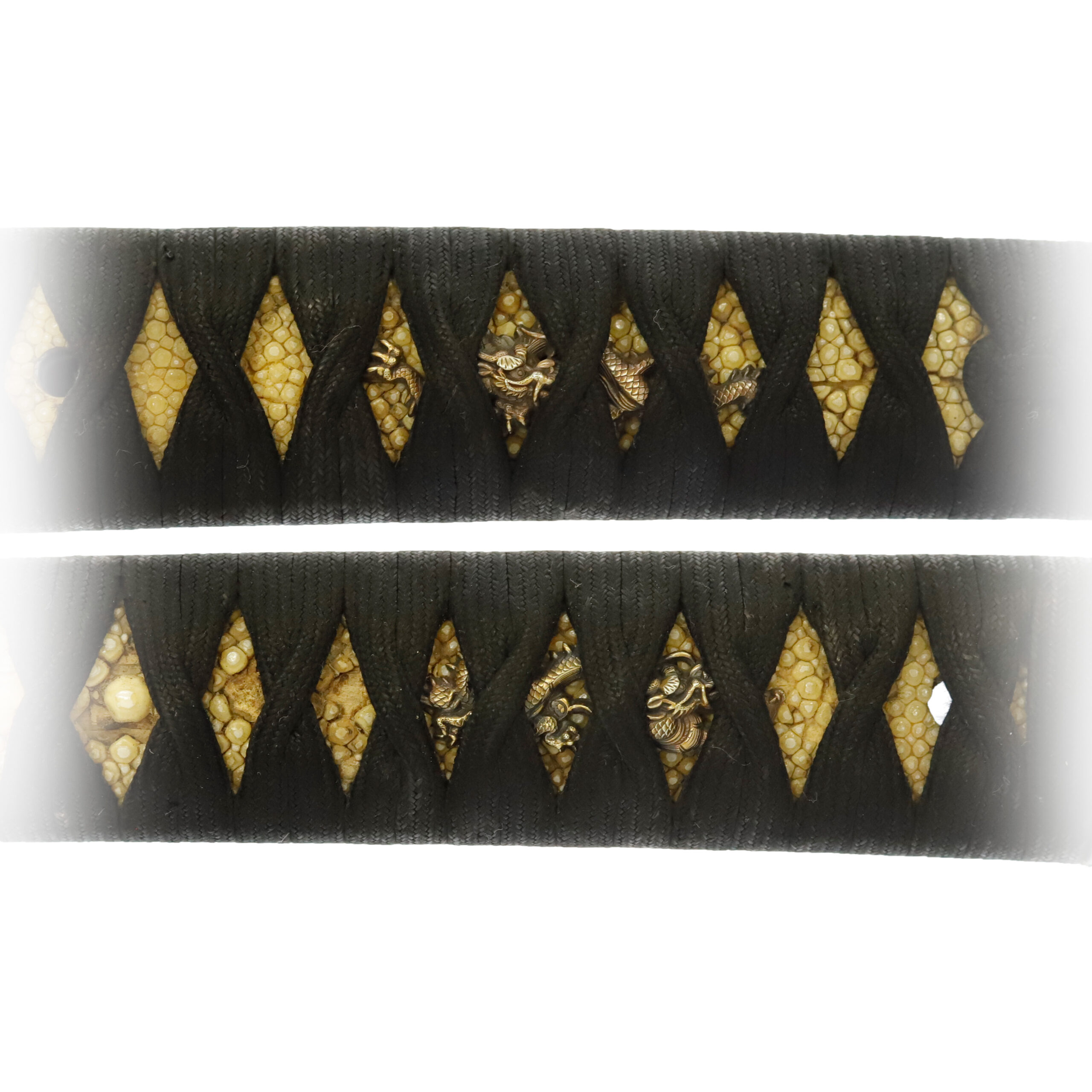
Tsuba and Habaki:Tsuba is the handguard for the Japanese Sword and Habaki is the equipment to make the blade not touch its scabbard inside. It prevents the blade from getting rusty and chipped.
The same as other sword mountings mentioned above, these Tsubas have common designs. These Tsubas seem to be made from iron, and golden inlay (estimated gold or brass) is effectively applied here and there on these Tsubas and makes their ornamental appearances. This golden inlay technique engraves several geometrical patterns; for example, the Asanoha (麻の葉, hemp leaf) design. It is a geometric pattern with hemp leaves as a motif combined with a regular hexagon. A triangle shape has been thought it has the power to protect people from evil spirits. Therefore, the hexagon shape, made of triangles, has been regarded as an amulet with more substantial power. Since hemp grows fast and has strong vitality, this plant pattern was often designed for children’s birth clothes wishing for their health and growth. Also, the Asanoha pattern has been used to decorate Buddhist statues since the Heian period (794-1185).
One other geometric pattern is the Saya Gata (紗綾形) pattern. It is a type of continuous design, and many Samurai loved it. According to a theory, this motif was brought from a foreign country to Japan in the Momoyama period (1568-1600). The Saya Gata pattern has a graceful appearance and represents the longevity and prosperity of the family.
Now let’s find a slightly bigger motif on these Tsubas. Double-flowered cherry blossoms divided in half are placed on the top and bottom of the screen. These flowers are combined with the snowflake patterns carved on the left and right sides of the screen, creating a design that heralds the arrival of spring. Cherry blossom is one of the seasonal things of spring, and it has been cherished for a long time in Japan. Its pattern is designed not only for sword mountings but also for Kimono (着物, traditional Japanese costume) or furnishings. One theory says that the god of grain exists in cherry blossoms. Therefore, this flower pattern has been treated as the symbol of a plentiful harvest. People held a traditional custom under cherry blossom trees to pray for a bumper year in ancient times. It is said this is the origin of the cherry blossom viewing picnic today.

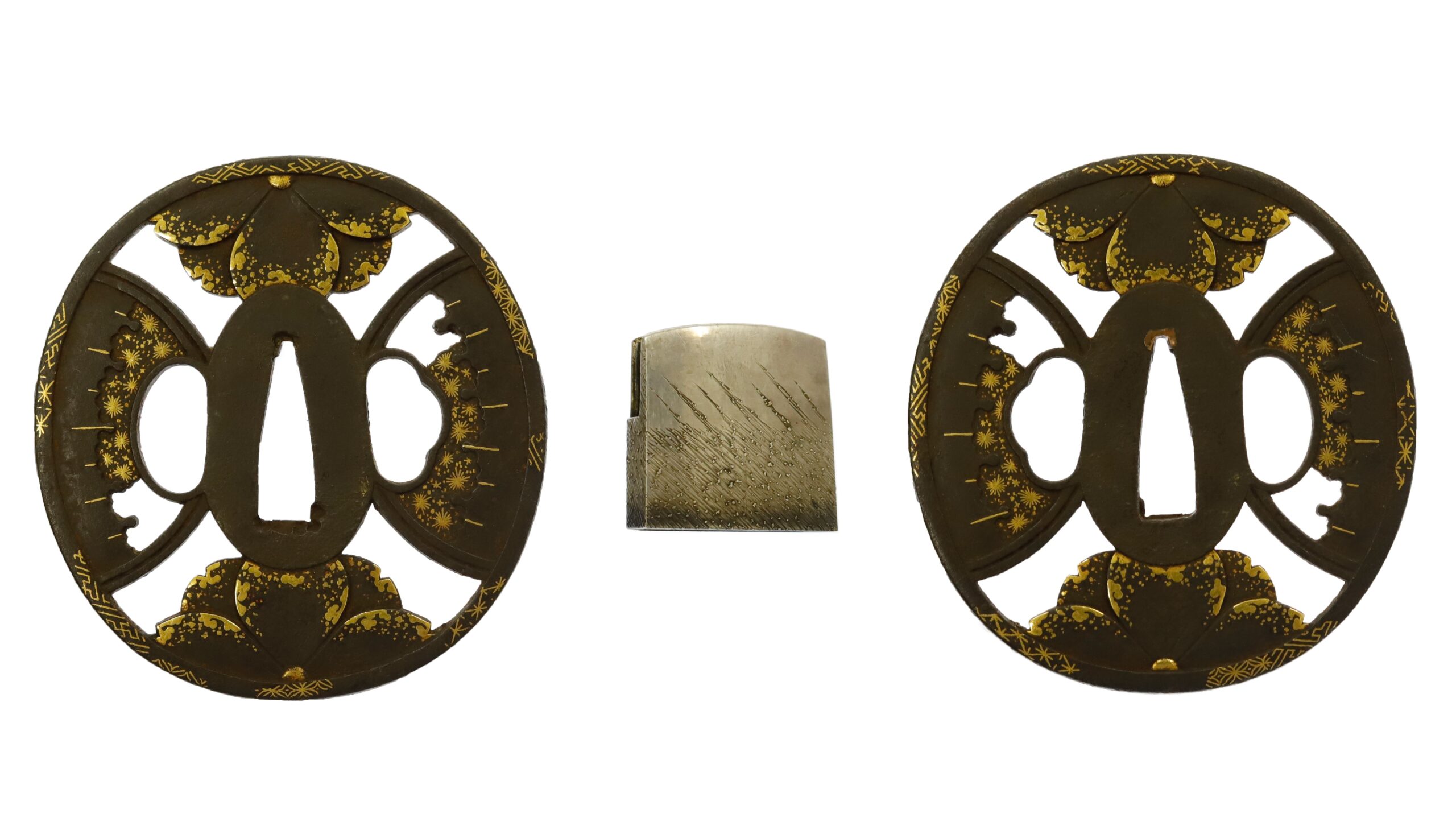
Saya: Saya is the scabbard for the Japanese sword.
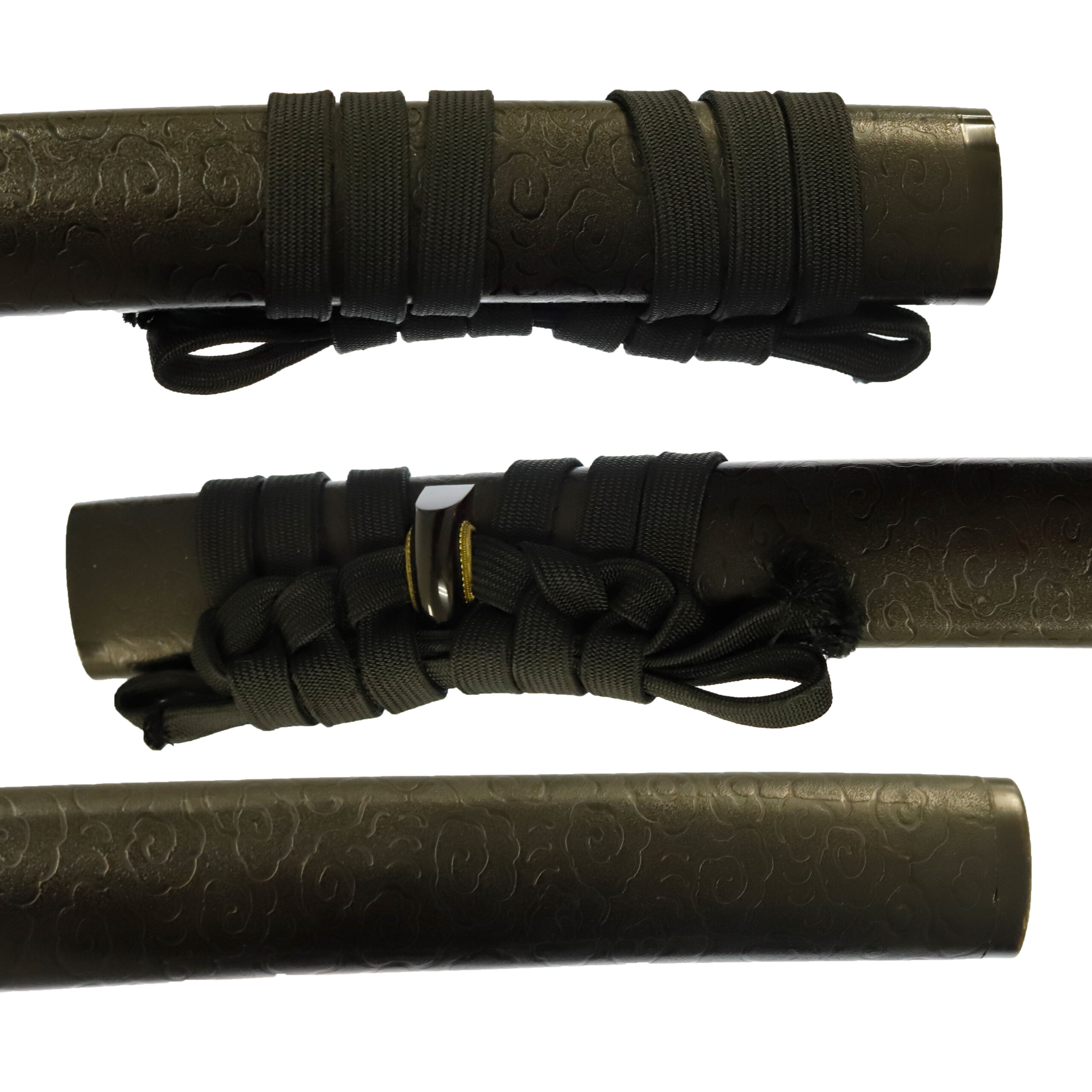
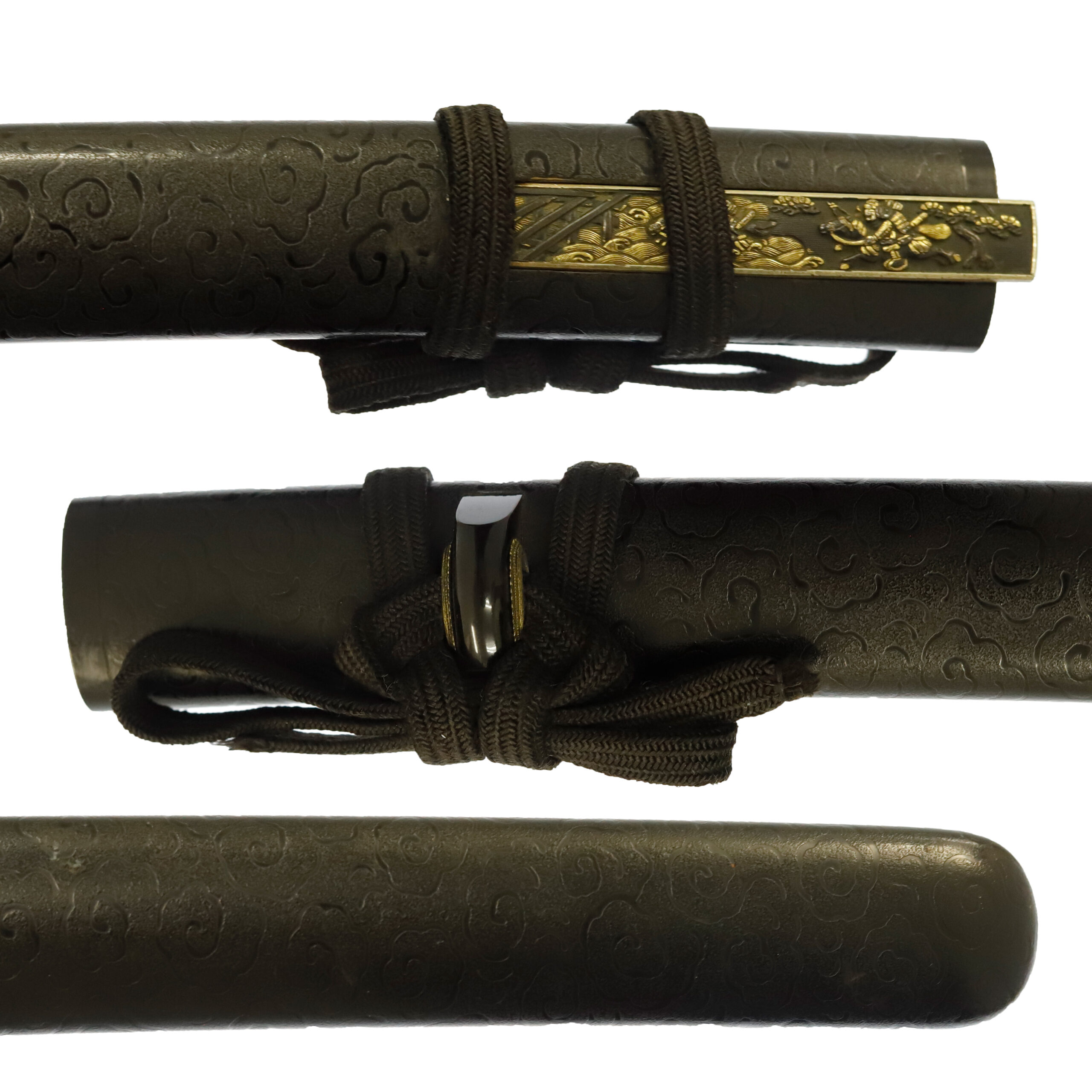
Kozuka:Kozuka is a small knife stored in Kozuka Hitsu (groove of the sheath of the Japanese sword).
A Kogatana (小刀, small knife) is stored in the Kozuka. Its design is related to the theme of the Fuchi Kashiras mentioned above.
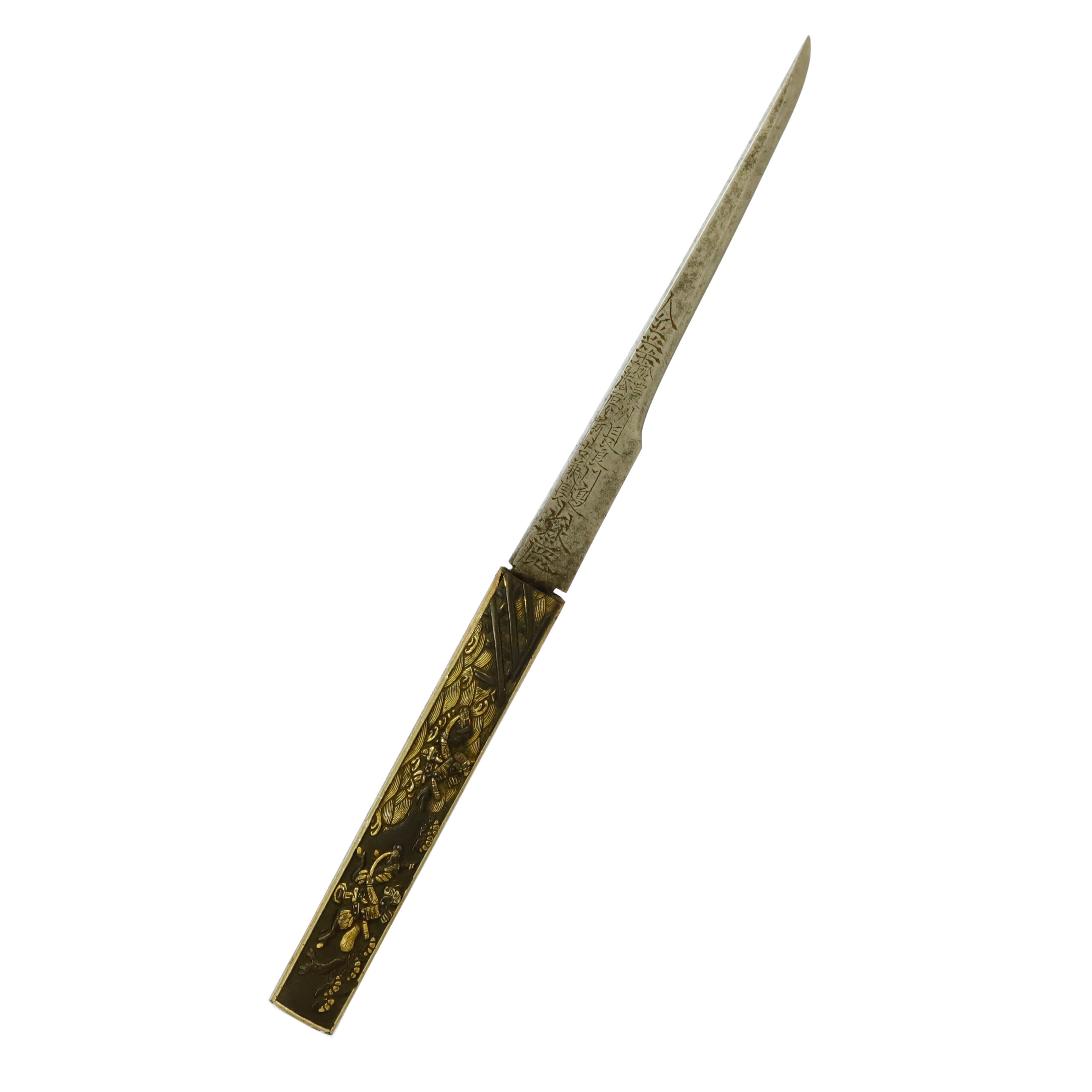
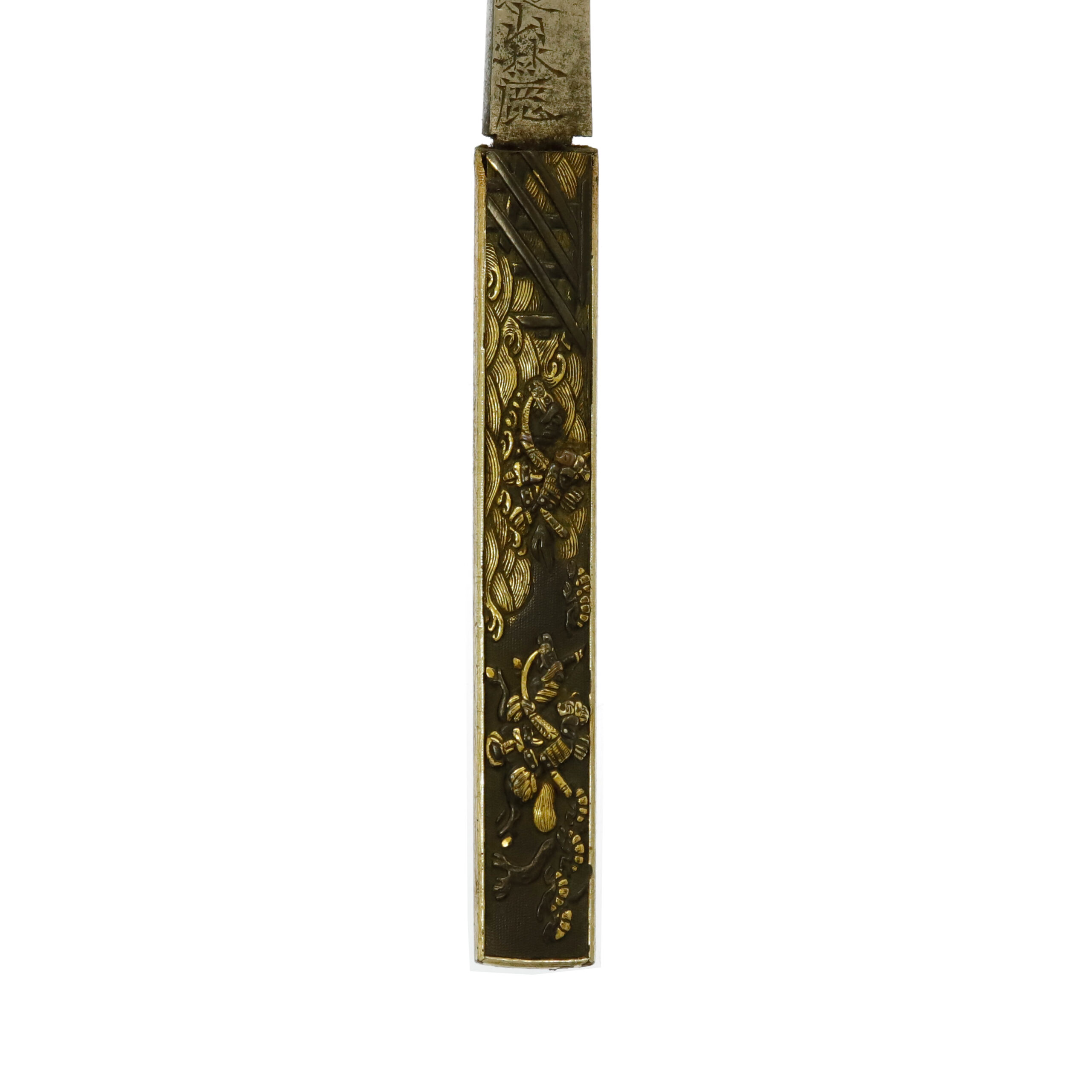
Authentication Paper:NBTHK Tokubetsu Hozon Certificate for the Katana (No.1020577) & Hozon Certificate Wakizashi blade (No.3031808)
NBTHK, also known as Nihon Bijutsu Touken Hozon Kyokai (the Society for the Preservation of the Japan Art Sword), is one of the oldest Japanese sword appraising organizations in modern-day Japan. They authenticated these two blades on May 31st in the 5th year of Reiwa(2023). They appraised Katana as a Tokubetsu Hozon Touken and Wakizashi as a Hozon Token, the blade worth preserving for Japanese society. The purchaser will receive these original certificates as well. We can also translate what is written into English and make a PDF file for your record if you request.
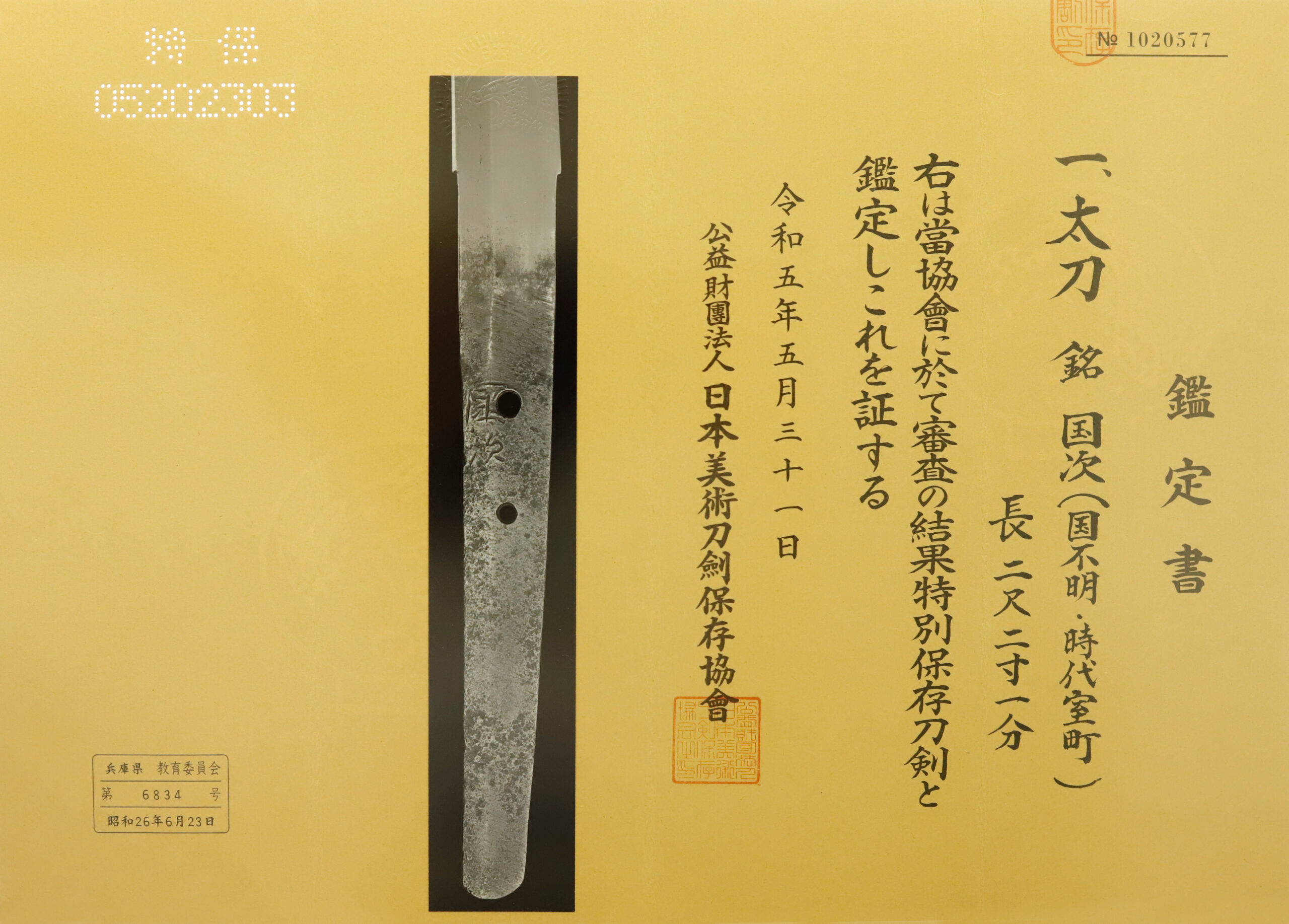
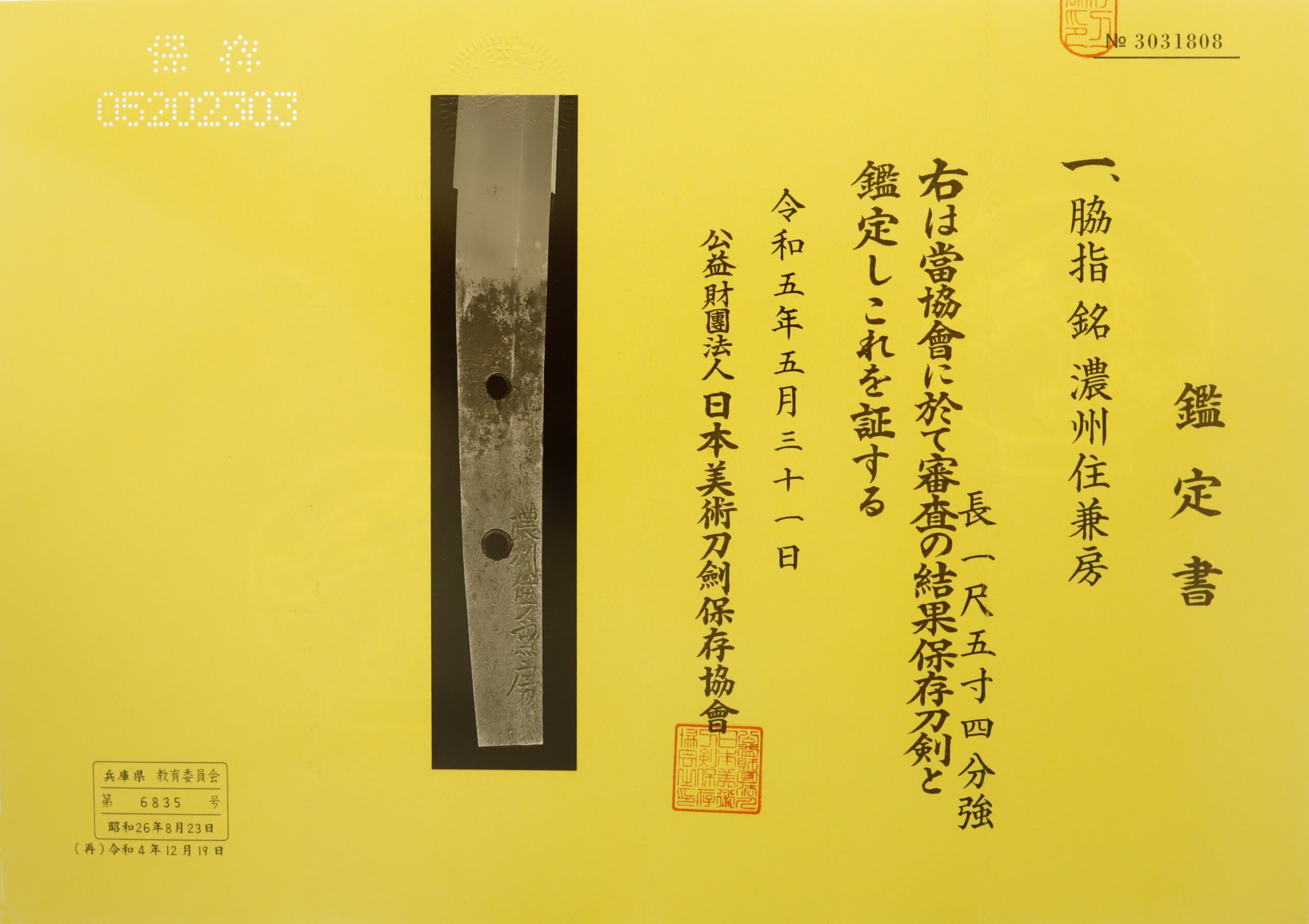
Registration Number : Hyogo 6834-6835
The Board of Education in Hyogo prefecture issued a registration paper for this Katana and Wakizashi blade . It is called Jyu Token Rui Torokusho(銃刀剣類登録証). Bunkacho(The Agency for Cultural Affairs) acknowledges a Japanese sword with this paper as a work of art.
The sword needs to be traditionally hand-forged and made of Tamahagane carbon steel to be registered in the system. With this paper, its owner in Japan can legally own an authentic Japanese sword. Based on this registration number, we will apply for its export permit.
This paper will need to be returned to the board of education when the sword is being shipped abroad, but you can receive a copy of it. An English translation of this registration paper is available on request.
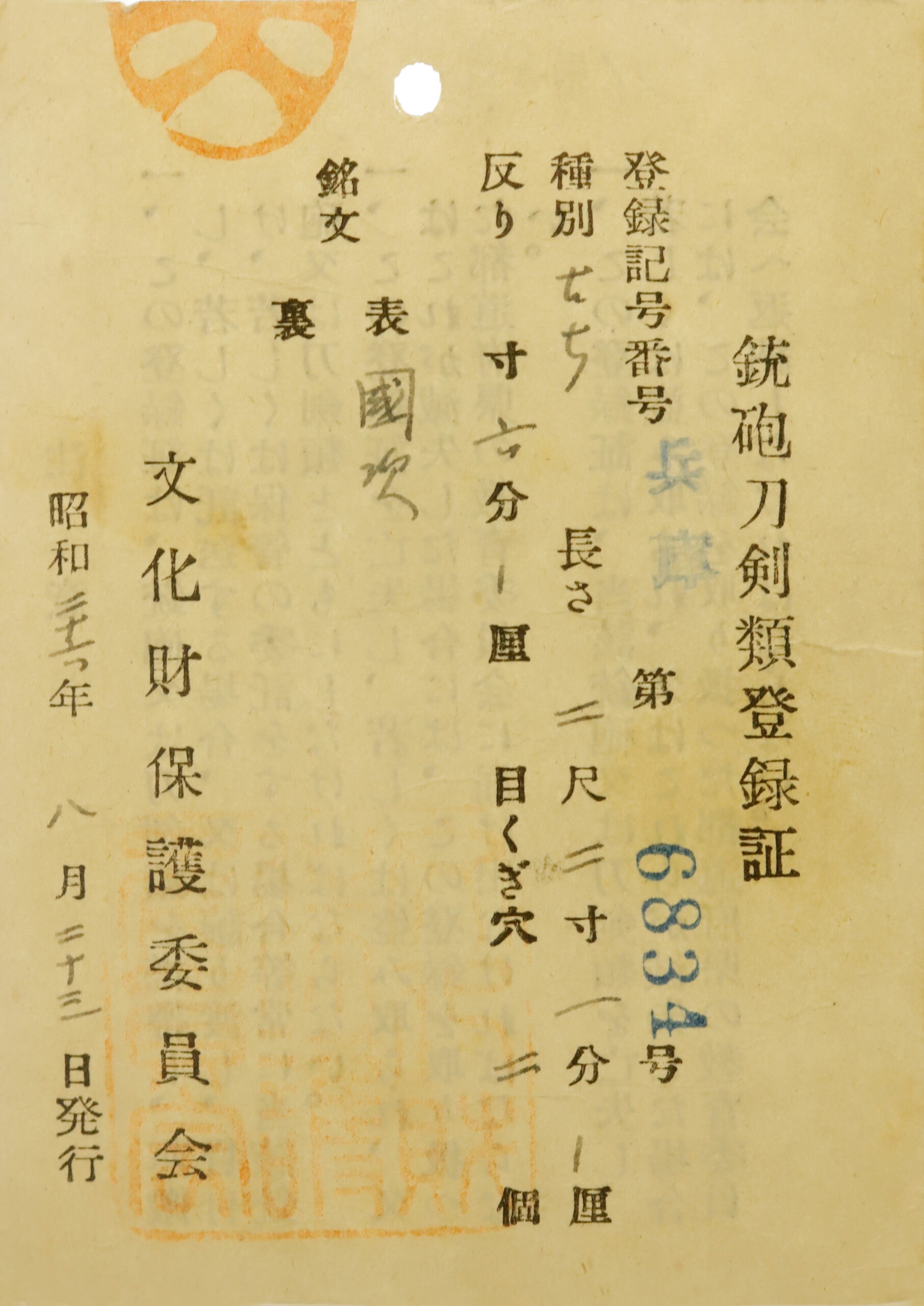
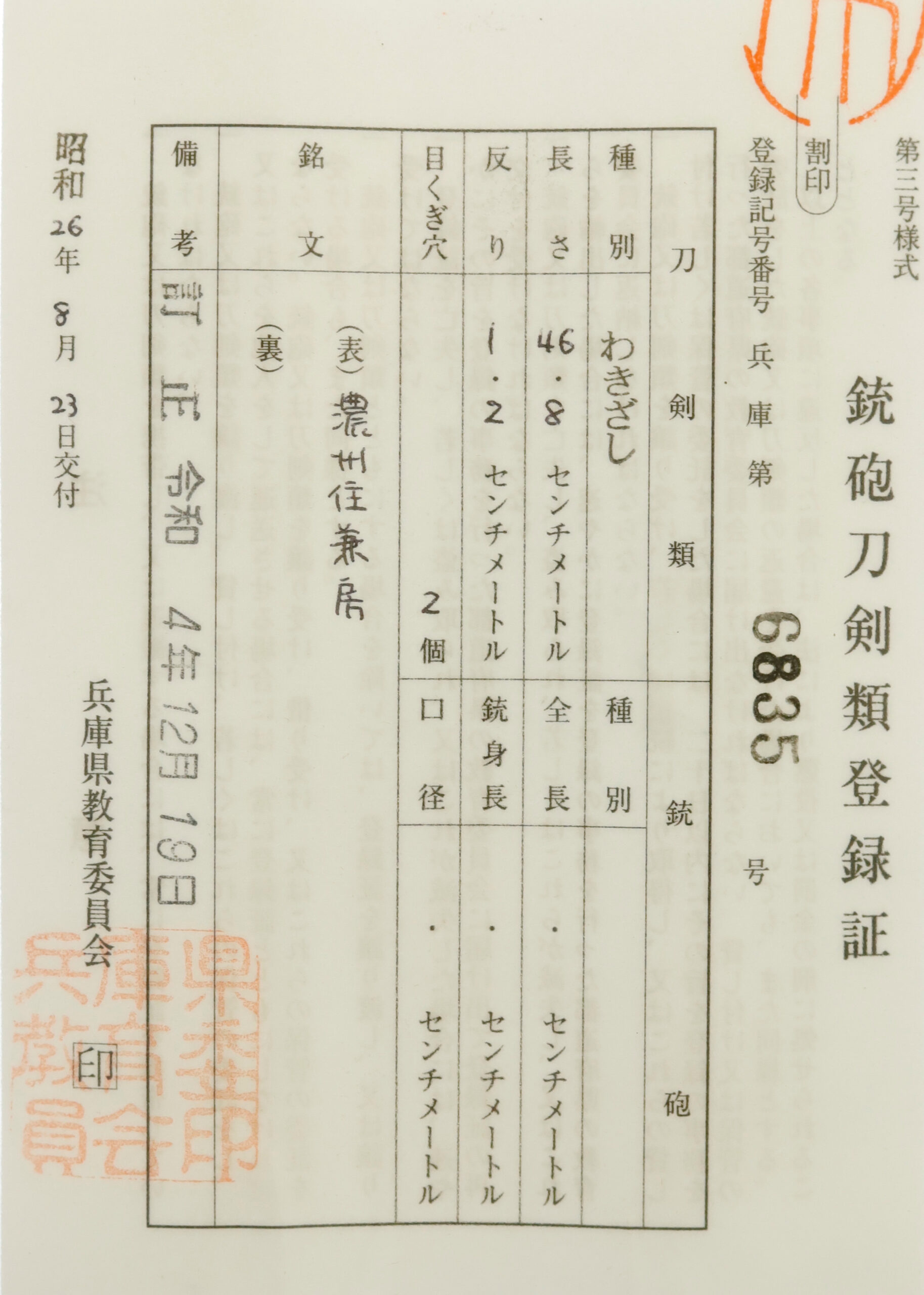
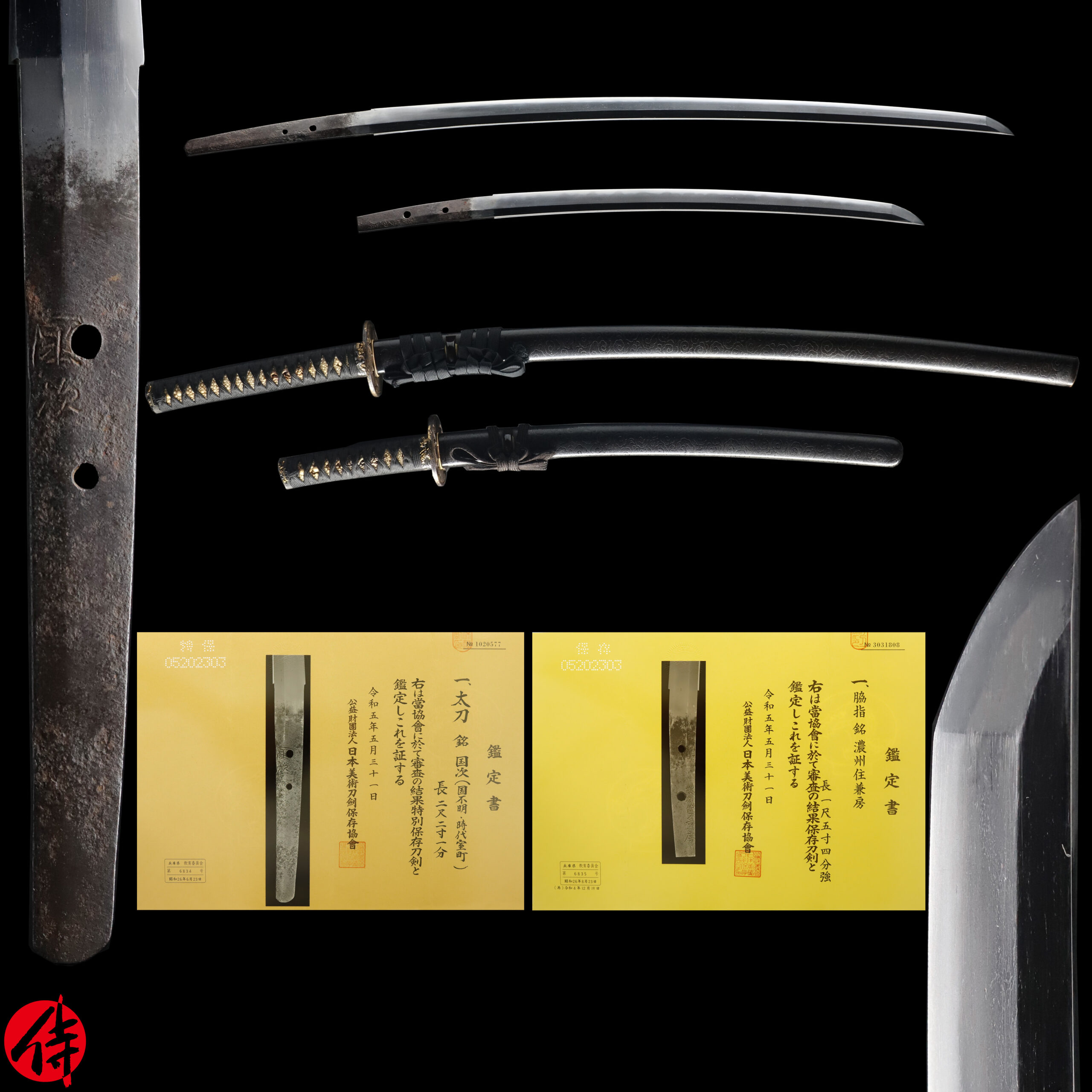
—————————————————————–
【About us】
Samurai Museum is located in Tokyo, Japan, exhibiting antique artifacts related to the Samurai history. Samurai Museum Shop is the place for those who are interested in Japanese culture and craftsmanship. We deal with antique Samurai swords/armor, traditional crafts made in Japan and so on.
【Japanese Sword& Export Process】
The Japanese swords we deal with are hand-forged edged swords made in Japan. It was made from the traditional carbon steel called TAMAHAGANE(玉鋼). Samurai Museum is familiar with the proper legal procedure for an antique/ authentic Japanese sword to be exported from Japan. We have sent more than 500 Japanese swords for the past three years (~2023) to amazing owners who appreciate its historical value.
Each Japanese sword is registered under the Agency for Cultural Affairs and the Board of Education in Japan. They issue a registration paper for each Japanese sword for its owner in Japan to legally possess it. The Japanese sword with its registration paper means it was traditionally hand-forged in Japan.
To legally export the sword from Japan to other countries, we will have to apply for its permit to the Agency for Cultural Affairs(Bunkacho) and return the original registration paper to the Board of Education. It normally takes around 2-4 weeks to receive this permit after submitting required documents. And we would like you to expect at least 1-1.5 months for your order to arrive at your given address after you ordered. For more detailed info, please click here.
It is allowed for residents in Japan to own authentic Japanese swords without a special license as long as they come with registration papers. Please feel free to contact us if you are a resident of Japan, whether temporarily or permanently. We will also assist you when you leave Japan and need to obtain the export permit.
【Payment Method】
We accept payment through Stripe (Credit card), PayPal, Apple Pay or ChromePay, all of which are secure payment methods. Also, you don’t need to make an account on Stripe for the checkout. If you prefer other payment method, please contact us. After confirming your payment, we will apply for an export permit. You may either pay in JPY, USD, AUD, CAD,EUR CHF or GBP. The price is set in Japanese Yen. Prices in other currencies are automatically calculated based on the latest exchange rate.

* If the amount is above 1 million JPY, Stripe or wire transfer will be the only options for payment.
【Shipping】
We have shipped authentic Japanese swords to the USA, UK, Canada, Mexico, Germany, France, Hong Kong and Australia. If you don’t live in these countries and like to order, please contact us first before making a purchase. We offer Free International Shipping as long as we can send antique Japanese swords by EMS.
We normally ship by EMS(Express Mail Service) provided by Japan Post. We will send you a tracking number for your order as soon as we hand it to the post office. We will put 100 % insurance on the shipping document without any extra charge. Based on the total amount, there might be a duty tax or other fee for you to pay, depending on the countries. We use package cushioning to protect the item and put it in a PVC pipe, which is one of the most secure packages because of its durability.
It will normally takes 5-14 days for the item to arrive at your given address after we dispatch it. Time of delivery is estimated as accurately as possible by the carrier but does not take into account any delays beyond our control such as by inclement weather, post office holiday seasons.
* If you live in Australia and like to purchase an authentic Japanese sword, please click here to know the detail.
*Please keep in mind that due to the spread of COVID-19, there might be delays in shipping. If you like to know the detail about shipping, please feel free to ask us.

【Review】
Here is one of the reviews we received from a customer who purchased an authentic Japanese sword from us. For more reviews, please click here.
“My experience overall with the whole process was wonderful. I had many questions about the history and process to purchase these treasures. All my questions were answered very timely and complete. The staff is very knowledgeable and very well versed if any questions do arise.”
【How to make sure the condition】
Please keep in mind that what you are going to purchase is an antique item. We uploaded high resolution photos for you to check its condition thoroughly. If you like to see more photos with different angles, please feel free to contact us. We will be happy to send them to you so that you can make informed decision. It is essential for us to know that you are happy with your choice of a sword. and we are prepared to use the best of our ability to serve you.
【How To Contact Us】
Please contact us through email, Facebook Messenger or Live Chat if you have any questions. You can find each icon on the right side of the website. Please click one of them to reach us. We will reply to you within 1-2 business days.
【The Art of Nihonto (Japanese Sword)】
Samurai’s history is a profound, eloquent legacy of ancient Japanese warriors in which millions of people worldwide are being fascinated. If you like to find out the art of Nihonto, please click here.
【A Guide to Japanese Sword Maintenance】
After acquiring an genuine Japanese sword, it is also important to know how to take good care of it. Here is the special video for you. Mr. Paul Martin, Japanese sword expert, shows you how to give proper maintenance to your sword. By mastering how to clean the Japanese sword, its aesthetic beauty will last forever.
When you purchase a Japanese sword from us, you can get a Free Japanese sword maintenance kit. It comes with four tools(Choji Oil, Uchiko Whetstone Powder, Peg remover, Oil Applicator). By watching the video instruction above , you can enjoy learning how to maintain your Japanese sword while appreciating it. If you have any difficulty assembling the sword or cleaning the blade, you can feel free to contact us.


MORE ANTIQUE JAPANESE SWORD FOR SALE
SWORDS WITHOUT CERTIFICATES FOR SALE
LEARN JAPANESE SWORD TERMINOLOGY
Thank you for reading all the information on the page. If you have any difficulty choosing the right Japanese sword for you, we will be more than happy to help you find the one that speaks to you the most. Please feel free to contact us.

